University of Oregon football team has brand-new ‘Pond’
EnviroStar to acquire Western State Design for $28 Million
MIAMI — Commercial laundry equipment distributor EnviroStar Inc. (EVI) reports it has executed a definitive asset purchase agreement to acquire substantially all of the assets of California-based Western State Design LLC, also a distributor of commercial, industrial and coin-operated laundry products, and provider of installation and routine maintenance services.

Closing of the transaction is subject to certain conditions, including financing. Pursuant to the agreement, the purchase price is $28 million, of which $18 million will be paid in cash at closing—which is expected to occur by mid-October— and $10 million in shares of EVI’s common stock.
Western State Design will operate as a wholly owned subsidiary of EVI under its current name, from its present West Coast locations, led by its existing management team and employees, and with the added benefit of EVI’s support and resources to assist Western in execution of its growth plans.

EnviroStar, which has served the laundry industry since 1959, also distributes drycleaning equipment, industrial boilers, and related parts, supplies and technical services. ALN
BY MATT POE, EDITOR
EUGENE, Ore. — Aaron Wasson was a busy man at the beginning of September.

As director of equipment operations for the University of Oregon, Wasson was in the middle of getting gear ready for the nationally ranked Ducks’ first football game.
He was also overseeing his department’s transition into a newly reconstructed facility.

“We’re in the process of moving in as well,” Wasson says. “It’s a pretty big equipment space, and we have construction trailers and tractor trailers, shipping contain-
ers around that we’ve had stuff in for a while.”
The new equipment space is part of the university’s new Marcus Mariota Sports Performance Center, which was named after the university’s Heisman Trophywinning quarterback (2014). Mariota is now the starting quarterback for the NFL’s Tennessee Titans.
Included in Wasson’s equipment space is a new laundry area, fittingly called the Pond. And as he was preparing the team’s equipment, Wasson was preparing his laundry team for its first game-day processing.

“We’re about three weeks in to using the laundry,” says Wasson.
Up to that point, the laundry had only seen workout gear, not
HX: The Hotel Experience expands new look and feel for 2016 edition of show
organizer Hospitality Media Group
(HMG).
The rebranded event drew more than 12,000 visitors in 2015, and HMG is expecting the 2016 turnout to be just as strong.
BY MATT POE, EDITOR
NEW YORK — HX has some exciting new features to highlight this year, now in the second year of a multimillion-dollar rebrand from the International Hotel, Motel + Restaurant Show (IHMRS) to HX: The Hotel Experience—Rooms to Restaurants, according to show
“2015 was a year of bold changes for the International Hotel, Motel + Restaurant Show (IHMRS). The rebrand from IHMRS to HX: The Hotel Experience—Rooms to Restaurants thrilled our audiences and gave a whole new life to the show in its 100th year,” says Phil Robinson, HX Group show director. “HX is now well-positioned to serve the sourcing, education and
networking needs of the hospitality industry going forward.”


The 2016 show will take place Nov. 13-15 at the Jacob K. Javits Convention Center.

The three-day event will feature more than 400 inventive exhibitors, knowledgeable speakers and eye-catching demos—all on one floor. HX 2016 includes three enterprise feature areas on the show floor, says HMG.
HX: TECH, sponsored by MasterCard, is home to technology education and will demo the latest tech tools and gadgets. HX: ONSTAGE-HOTEL will fea-
Panel of Experts
Our experts examine what to track in a laundry operation.

OCTOBER 2016
News
game-day laundry. But, with a doubled capacity, Wasson was sure
Late
www.americanlaundrynews.com Volume 42, Number 10 INSIDE [28] See OREGON on Page 6
The Newspaper of Record for Laundry & Linen Management
[4] See HX on Page 10
Columnist at Large Eric Frederick discusses the old-fashioned value of loyalty.
[22]
Second year to include more technology, demos
Laundry that took ‘half the night’ now done in 1.5 hours, says director of equipment operations
The University of Oregon’s new football laundry features six washers and six dryers. (Photos: Eric Evans, Oregon Athletic Communications)
“HX IS NOW WELLPOSITIONED TO SERVE THE SOURCING, EDUCATION AND NETWORKING NEEDS OF THE HOSPITALITY INDUSTRY GOING FORWARD”
NAPERY & TABLE LINENS PRODUCT SHOWCASE
—PHIL ROBINSON, HX GROUP
ALEXANDRIA, Va. — The Textile Rental Services Association (TRSA) says that its Hygienically Clean Advisory Council will convene this month to consider upgrades to the textile services certification programs it oversees, examining further opportunities to validate processes and quantify outcomes for launderers serving healthcare, food safety, food service, hospitality and other businesses.
TRSA says compliance with Hygienically Clean standards requires textile services to adhere to best laundry practices and microbial content limits on cleaned textile products before delivery to customers.
tion risk than others. Compliance requires description of how such risk is controlled (eliminated or reduced), the association says.
For example, washing is often considered a CCP. Risk is controlled in large part by inspecting proof-of-delivery reports generated by systems that inject liquid detergent into washers according to the proper formulas and monitor implementation of these formulas.
CCPs are part of TRSA’s Hygienically Clean Food Safety certification, addressing high demand from food manufacturers and processors for their suppliers to deploy hazard analysis and CCP (HACCP) concepts. HACCP is also incorporated into the Hygienically Clean Food Service standard to address restaurateurs’ concerns regarding their supplies’ hygiene as restaurant patrons grow more concerned about these facilities’ cleanliness practices.
tinentwide laundry protocols to address their countries’ specific hygiene concerns.
Earlier this year, the Textiles and Textile Products technical panel of the European Committee for Standardization (CEN) revised EN 14065, improving the standard’s guidance of laundries in establishing their own risk analysis and biocontamination control (RABC) processes, according to TRSA. Individual nations’ CEN affiliates and their respective certifiers can add provisions to the Europe-wide standard similar to the Hygienically Clean requirements. CEN’s deadline for its national affiliates to present EN 14065 to constituencies was Aug. 31.
The association introduced routine microbial testing protocols to the North American laundry industry when it launched the Hygienically Clean program in 2011 and pledged to continuously improve standards.
In the current review, the Advisory Council is considering upgrades largely related to adding Critical Control Points (CCPs) to the Hygienically Clean Healthcare and Hospitality designations, according to TRSA.
CCPs are the steps in a process that pose higher biocontamina-
TRSA says that members who serve on the Hygienically Clean council—mostly launderers but including representatives of healthcare and academic professions—are considering how various washing, drying and finishing systems and functions might factor into CCPs. Controls might include additional microbial content testing of:
• Textiles at various stages of laundry processing, not just immediately before delivery.
• Wash water.
• Hard surfaces of machinery, storage and carts.
Hand hygiene requirements are also being weighed.
The council’s deliberations coincide with national standardssetting bodies in Europe deciding how they will modify new con-
Neither TRSA’s standard nor EN 14065 stipulate which steps in a launderer’s process must be declared CCPs. Both call for CCPs to be applied, however, with EN 14065 now distinguishing between basic control points (any step requiring control) and critical ones.
“Hygienically Clean’s approach of requiring launderers to apply general best practices but not mandating specific techniques fits well into the EN 14065 model,” says TRSA President and CEO Joseph Ricci. “Including HACCP in certification requirements without stipulating every detail of its implementation recognizes that launderers, supported by their suppliers, are most qualified to identify contamination risks in their own operations and address them properly.”
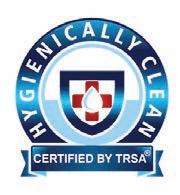
Hygienically Clean specifies microbial content levels for laundered textiles and laundry work surfaces without dictating the tactics to achieve them.
The recent European standard revision “continues to offer a framework and does not
define specific hygiene levels,” leaving that function to certifiers, reports Robert Long, secretary-general, European Textile Services Association (ETSA). Key additions besides CCPs, he says, include quantitative risk analysis and improved definitions of process validation, verification and monitoring.
“As before, the standard does not contain any specific requirement levels, leaving a lot of flexibility in terms of how principles are applied,” says Eoin Flavin, the U.K.-based member of TRSA’s Hygienically Clean Advisory Council who directs wash chemistry supplier Washing Systems Ltd.’s European operations. “We continue to need this flexibility to cater to different requirements in different sectors and countries.”
The TRSA council is slated to meet again in November at the TRSA Healthcare Conference.
The Hygienically Clean Users Group also will meet there. The conference will feature a presentation on applying HACCP to the healthcare laundry sector, explaining how it guides risk identification and otherwise protects healthcare customers and laundry plant employees.
The TRSA members-only conference is slated for Nov. 30-Dec. 1 in Nashville, Tenn. ALN

Publisher
Charles Thompson
Phone: 312-361-1680
E-Mail: cthompson@ ATMags.com
Editorial Director
Bruce Beggs
Phone: 312-361-1683
E-Mail: bbeggs@ ATMags.com
Editor
Matt Poe
Phone: 231-740-2842
E-Mail: mpoe@ ATMags.com
Digital Media Director
Nathan Frerichs
Phone: 312-361-1681
E-Mail: nfrerichs@ ATMags.com
Advisory Board
Jim Buik • Richard Griffin
Greg Gurtler • Phil Hart
Janice Larson • Tom Marks
Gerard O’Neill
Richard Warren
Production Manager
Roger Napiwocki
National Sales Director
Donald Feinstein
Phone: 312-361-1682
E-Mail: dfeinstein@ ATMags.com
Main Phone: 312-361-1700
Subscriptions
630-739-0900 x100 www.americanlaundrynews.com
American Laundry News (ISSN 1091-9201) is published monthly. Subscription prices, payment in advance: U.S. 1 year $46.00; 2 years $92.00. Foreign, 1 year $109.00; 2 years $218.00.
Single copies: U.S. $9.00; Foreign $18.00.
Published by American Trade Magazines LLC, 566 West Lake Street, Suite 420, Chicago, IL 60661.

Periodicals postage paid at Chicago, IL, and at additional mailing offices.
POSTMASTER, Send changes of address and form 3579 to American Laundry News Subscription Dept., 440 Quadrangle Drive, Suite E, Bolingbrook, IL 60440. Volume 42, number 10. Editorial, executive and advertising offices are at 566 West Lake Street, Suite 420, Chicago, IL 60661. Charles Thompson, President and Publisher. American Laundry News is distributed selectively to qualified laundry and linen management and distributors in the United States.
© Copyright AMERICAN TRADE MAGAZINES LLC, 2016. Printed in U.S.A. No part of this publication may be transmitted or reproduced in any form, electronic or mechanical, without written permission from the publisher or his representative. American Laundry News does not endorse, recommend or guarantee any article, product, service or information found within. Opinions expressed are those of the writers and do not necessarily reflect the views of American Laundry News or its staff. While precautions have been taken to ensure the accuracy of the magazine’s contents at time of publication, neither the editors, publishers nor its agents can accept responsibility for damages or injury which may arise therefrom.

2 OCTOBER 2016 | AMERICAN LAUNDRY NEWS www.AmericanLaundryNews.com
MEMBERSHIPS INSIDE: October 2016 • Vol. 42 | No. 10 [8] Tools of the Trade [14] Utilities Efficiency Upgrades, Savings Potential Benchmarking and maintenance are key to positively influencing the three big utilities—electicity, water and gas [20] Value of Certified Service Technicians In this month’s OPL 101 column, learn five reasons why to turn to a certified service technician for equipment support [30] Career Track [34] Trade Ticker [35] Classified Advertising [37] Source Directory IN THE CURRENT REVIEW, THE ADVISORY COUNCIL IS CONSIDERING UPGRADES LARGELY RELATED TO ADDING CRITICAL CONTROL POINTS (CCPS). TRSA considers textile services certification programs revisions Due to an editor’s error, the listings for Friedman & Co. and Commercial Laundry Sales & Service were inadvertently omitted from the Distributors Directory published in September. American Laundry News regrets the error and any inconvenience it may have caused. FLORIDA Friedman & Co. T O Ocala, FL 344481 B 352-401-0251 l lee.friedman@gmail.com KANSAS Commercial Laundry E C P O Sales & Service 1228 S Santa Fe St. Wichita, KS 67211 B 316-267-6650 O www.clsands.com r Larry Asher l lasher@clsands.com ALN CORRECTION
Is your laundry costing you?
Milnor has a new solution for mid-sized hotels and hotel compounds looking to save both time and money. Milnor’s five-module “short” tunnel washers can have a significant effect on your water and energy consumption, without compromising linen quality your guests deserve. We’re talking about using as little as 0.3 gallons of fresh water per pound of room linen instead of 2 or more gallons in a large washer-extractor.
No matter how dirty your sheets, towels, or tablecloths are, hotel laundries across the country have seen remarkable improvement in wash quality with a dramatic reduction in water usage and energy. And now, if your facility washes 1,000 pounds of linens an hour or more, you can take advantage of PulseFlow technology in a new, smaller five-module tunnel.

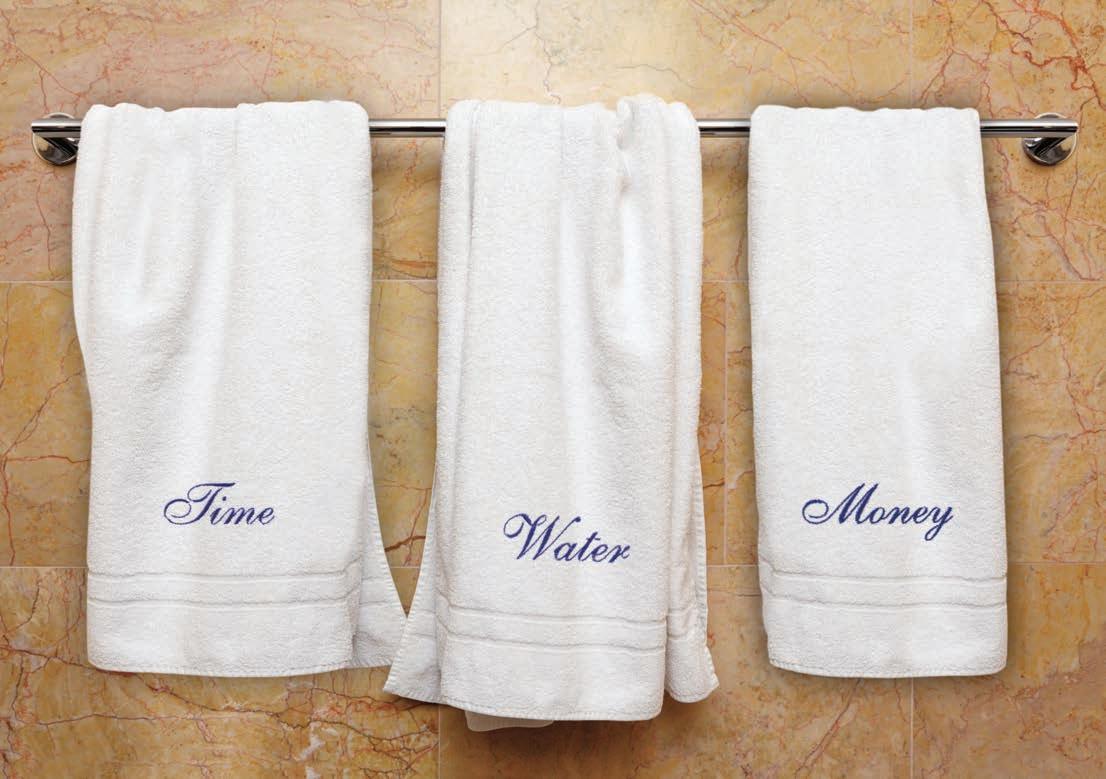
Contact an authorized Milnor distributor or call 504-712-7656 to find out more about getting big savings with a modest footprint.
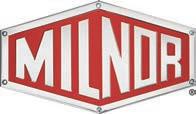
www.milnor.com / pellerinmilnor *Patent applied for
It’s time to be practical
LOYALTY:
T
he October issue of American Laundry News is, you could say, very practical.
Inside, we present quite a bit of practical advice about equipment, utilities and markets.
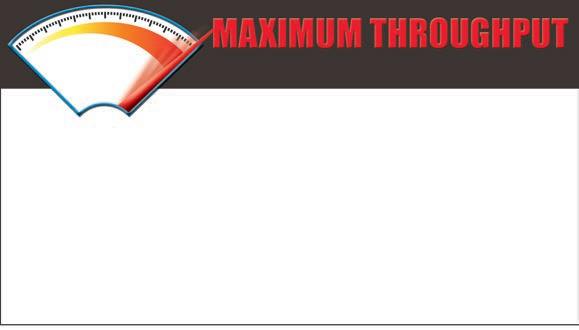
Editor Matt Poe has been attending webinars and conferences, gathering tips and suggestions from industry experts that might help you in managing and operating your laundries.
For example, if your operation uses a flatwork ironer, that piece of equipment may be causing you more rewash than you want. Turn to page 24 for 10 tips from David Rovetto of Tingue to help “squash the rewash.”
Maybe you run an on-premise laundry and have other equipment that has been giving you
The Director’s Chair BRUCE BEGGS
fits. UniMac’s Bill Brooks has some advice for you: use a certified service technician (turn to page 20 to learn more).
Do you rent wipers to your customers? Do you have some clients that make it difficult, shall we say, to keep as wiper clients?
It may be time to look into providing them with a disposable option (page 16).
One area in which you’re likely always on the lookout for help is utilities. On page 14, David Bernstein from Lapauw USA looks at each type of utility you use—electricity, water and natural gas—and shares ideas to reduce usage and save money.
Even our Panel of Experts is handing out practical advice in this issue (page 21), tackling the question of what data is important to track in a laundry and why.
So, keep reading and make use of all of the practical advice in this issue, along with reading about what’s happening in the industry. ALN
ARCO/Murray completes two laundry builds for rental company Alsco
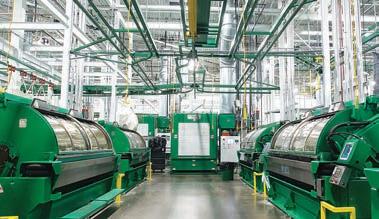
LANHAM, Md., and POMPANO BEACH, Fla. — Design/ build firm ARCO/Murray reports it has completed two laundry builds for Alsco.
In Lanham, ARCO/Murray built an 82,500-square-foot food and beverage laundry plant for the linen and uniform rental company. The Pompano Beach build was a 33,000-square-foot multistory addition.
The scope for each project included architecture and engineering design, permits, electrical and process mechanical installation, and final equipment utility connections.
ARCO/Murray says the Lanham site included a 7,800-square-foot office space build and 12,600 square feet of new mezzanine. Equipment installed included Ellis
washing systems, Ryco conveying systems, Automation Dynamics sort systems, Ludell water systems and Ellis wastewater treatment.
At Pompano Beach, the company says it performed a multi-phased
building and site expansion so that Alsco could continue operations during construction. The redevelopment included new storm sewers, detention, loading docks, parking and landscaping. ALN
An old-fashioned attitude needed in laundry management
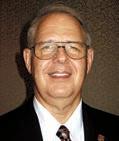
I have had the privilege to work for a number of companies over the many years of my career in the laundry industry.
I have had some great bosses, some good bosses, some meddlesome bosses and some just plain old terrible bosses. No matter what I thought of them, they were the boss and deserved my best efforts and my loyalty. I did not always agree with the way they wanted to get things done but they always deserved and got my best efforts.
I have come to realize that my attitude might be a little oldfashioned and no longer respected by the younger generation. It is common to hear members of leadership teams complain about the boss and question his or her decisions.
In a healthy environment, a manager will accept and consider input from all the parties involved. This input is vital in coming up with the best possible solution. I enjoy the opportunity to express my opinion to my boss and welcome the opportunity to explain in detail why I recommend that course of action, but once the decision is made, it is made and my job is to fully support that decision.
“NO MATTER WHAT I THOUGHT OF THEM, THEY WERE THE BOSS AND DESERVED MY BEST EFFORTS ... I DID NOT ALWAYS AGREE WITH THE WAY THEY WANTED TO GET THINGS DONE BUT THEY ALWAYS DESERVED AND GOT MY BEST EFFORTS.”
It is unrealistic to believe that the boss will always see things my way. He often has many demands on his time and has access to information that I do not. I trust that he will make the best possible decision for the organization as a whole. It is my job, and the job of all management team members, to fully support that decision.
I also must have loyalty to the organization, and if my boss has asked me to do something immoral, illegal or unethical, then I need to bring it to the attention of the proper authorities in the organization. Allowing inappropriate behavior to continue could cause major damage to the company.
But this should be the rare exception to the rule. I, personally, in 45 years of management have never been asked to do anything unethical, illegal or immoral by my boss, but I can honestly say I have not always agreed with their decisions.
Every manager must decide if they disagree with the direction their boss has chosen, whether they can fully support that decision or if it is time to move on.
I look at this type of situation as if my wife and I are taking a trip together. There are many ways to get from point A to point B. We can discuss if the scenic route or the most direct route is the best way to go. She has her reasons. I have mine. In the end, we make a decision on how we are going to travel.
•
WEBSITES
•
•
•
•
•
It makes little difference which route we take. The goal is to get from point A to point B, and 99% of management decisions are made on how the organization can best get from A to B. Everyone will not get to take their preferred route.
What is important is that the management team supports the decision and shows that support to its employees and to everyone it comes into contact with outside the organization. ALN
Eric Frederick is director of laundry services for Carilion Laundry Service, Roanoke, Va., and a past president and manager of the year of the Association for Linen Management. You can reach him by e-mail at efrederick@carilion.com.
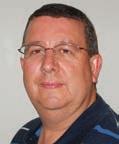
4 OCTOBER 2016 | AMERICAN LAUNDRY NEWS www.AmericanLaundryNews.com
From
COLUMNIST AT LARGE Eric L. Frederick, RLLD
Top Stories Appearing on AmericanLaundryNews.com for the 30 Days Ending September 15 (WE) = WEB EXCLUSIVE NEWS • Cintas Corp. to Acquire G&K Services Inc. • Overtime Exemption Rule Changes Dec. 1 • Study: Microfiber Products Help Prevent Spread of MRSA
UniFirst Opens High-Tech Facility in Baton Rouge
ARCO/Murray Completes Two Laundry Builds for Alsco COLUMNISTS/FEATURES • Healthcare Laundry Self-Regulation Goes Under the Microscope • OPL 101: Keeping Linens Off Life Support
•
•
Eric Frederick: Finding a Better Way to Handle Small, Dry-Fold Pieces
Laundry in Transition: Continuity in Family Business OUR SISTER
AmericanDrycleaner.com:
From
Washio Washout
Rare Air: Sixth Generation Works for Zengeler Cleaners
AmericanCoinOp.com:
From
On-Demand Laundry Service Washio Abruptly Ceases ...
Third Generation of Rawlins Family Joins R&B Wire ...
Alsco’s Lanham, Md., facility was expanded with a new food and beverage laundry plant.
(Photo: ARCO/Murray)



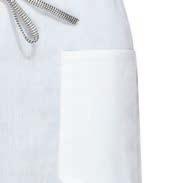
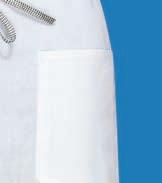
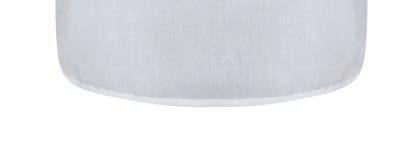



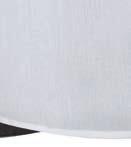



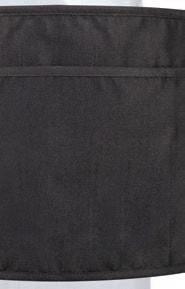


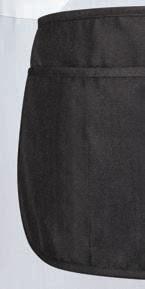

800 821 2221 | imagine@americandawn.com | americandawn.com BECAUSE PROFESSIONAL WAIT STAFF DESERVE CLEAN APRONS THE INDUSTRY’S FIRST RENTAL APRON FOR THE FRONT OF THE HOUSE The ADI Server Pro Collection M ade from Rental Friendly Spun Polyester Server Apron Has 3 Pockets For Straws, Pens, Checks Bistro Apron Has 2 Pockets (Available in Black or White) M ade With The Professional Waiter In Mind O2311BLKMTIM O7529BLKIM O7529WHTNWI
the process would go smoothly.
FROM PUDDLE TO POND
The program’s previous laundry facility, according to Wasson, was a small room that served the football program and some of the university’s other programs.
“In the previous laundry facility, we had three washers and two dryers,” he says. “We had a capacity of about 250 pounds.”
With the center, everything about the laundry is newer, and bigger.
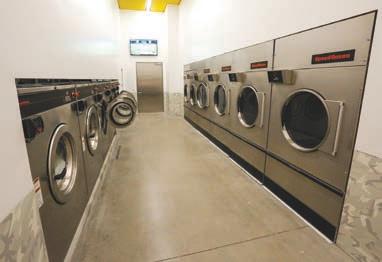
“We basically reconstructed the entire facility [known as the Casanova Center],” Wasson says. “We drilled all the way down to rock and poured a new slab for the entire facility, and moved everything around. Moved electrical. We moved water to a totally different side, probably 50 yards away from where the laundry facility was. We just totally wiped that out and started new.”
When it came to equipment, Wasson says the construction team researched three different manufacturers and interviewed all three. In the end, they went with Speed Queen hard-mount washers and dryers—six of each. He says four of the washers are 80 pounds in capacity and two are 60 pounds, with the dryers being their equivalents.
According to Wasson, the laundry uses the Tide Professional Laundry System industrial product. In addition, he’s particularly proud of the facility’s lint trap, provided by Cleaning and Laundry Equipment Co. out of Portland. He says the lint containment system “is just massive.”
“We spent a considerable amount of time on our laundry facility because we have our student managers who come in and do laundry at off hours, and we wanted to make sure that we were in a safe space and large enough that they could move around laundry carts and had cabinets that they could store product shelving where they could do a lot of folding,” says Wasson.
According to Wasson, the Pond connects to the manager break room and the locker room. This provides the student managers access so they can be in working at odd hours when the equipment room isn’t actually open.
“They have access to all of these areas,” he says. “There’s a speaker system, a stereo system. There’s a computer and a television that’s tied into the speaker system. It’s a really nice space for them. We’re really happy with the way it came out.”
One part of the laundry room that Wasson says he and his team put a lot of thought into was where the chemicals were going to be stored and how to get the chemi-
cals to the washers. The solution? Run the lines up and over so laundry staff could walk back behind the washers to make it easy to do maintenance.
“We took all of the electrical up and over, as well as the water and the lines for the chemical, up and over, where it probably goes up to 8 to 10 feet, over and then back down,” Wasson says. “You can easily walk right behind the washers.”
Wasson also wanted to eliminate backflow or clogging issues in the new facility, so system designers doubled the size of the drainage that was called for.
“We doubled the size of the trough as well as the piping that runs through it,” he says.
Finally, Wasson and his team needed to be creative when it came to cart storage.
“We have hard-sided, plastic laundry carts, and we have two dozen of those,” he says. “We were trying to find a place where they could be stored when they weren’t being used, instead of taking up floor space or stacking them.”
“There were essentially two different projects that we ended up turning into one,” Wesson says.
One project was a sports performance center for testing athletes and enhancing their performances. The three main areas of the performance center’s technologies are recovery, physiology and movement.
“That was one part of the project, with motion capture cameras, force plates, those types of things,” Wesson says. “Australia is way ahead of the curve in that respect. We wanted to be the first collegiate university in the United States to really emphasize that type of testing and analysis for our studentathletes.”
The other project was to expand and remodel the equipment room for the football program and some of the other athletics programs, such as baseball, soccer and lacrosse.
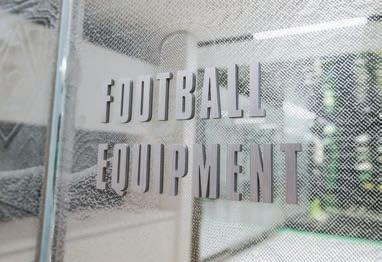
“We had about 30,000 square feet to work with for those two projects,” Wasson says. “We essentially split the two projects. One side of the facility is sports performance and the other side is our equipment room.”
He says that the decision to combine the projects happened about two years ago. After that, the project team went into research mode.
Wesson says they made numerous visits to places like Gatorade, NASA and Red Bull, plus spent a week in Australia, all to research the sports performance side of the project.
To solve that cart storage issue, Wasson partnered with a company called Spacesaver Specialists Inc. out of Tualatin, Ore. The company offers rolling shelving units that take up half the space, and Wasson challenged them to come up with a way to store and move their carts.
The company built a platform that is attached to, and comes out of, the wall, says Wasson. He says the unit can handle four laundry cart stacks on it at once, and then it carries the carts up and stores them against the wall.
“You can walk underneath it. You can store things underneath it. You just press a button and the laundry carts come down to the floor level, take them off the shelf and you’re ready to go. That’s a pretty cool contraption,” says Wasson. “Overall, it’s a really nice space.”
COMBINED PROJECT

The entire Marcus Mariota Sports Performance Center is “a really nice space,” and plans for the center began three years ago, Wesson says.
At that time, the university had completed its new football operations building called the Hatfield Dowlin Complex. Then, he says, the program started looking at what its next big project—the next big facility need—would be.
Then, he says, the team took another week in the States, traveling across the country looking at equipment rooms and laundry spaces serving teams in the collegiate and NFL ranks.
“I think we went to seven different equipment rooms and laundry spaces in three days in February 2015,” says Wesson. “We spent a morning with the Seattle Seahawks. We spent some time at Notre Dame, Louisiana State and Oklahoma State. That’s how the process began. We were able to take a look at what they had and put our own spin on it.”
CENTER TOUR
Oregon’s “spin” on both halves of the project has resulted in a stunning performance and equipment center.
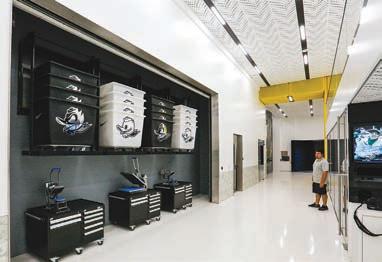
Entering from the west, studentathletes walk into a trophy lobby that is a tribute to the center’s namesake. Trophies for the Walter Camp Player of the Year, Johnny Unitas Golden Arm Award, Davey O’Brien Award, Maxwell Award and Manning Award are displayed in the lobby.
One wall has a transparent LED flat-screen television that shows highlights of Mariota, and then reveals a shadowbox with memorabilia of his from Hawaii (where he played high school football). There is also a playful illustration of a Pacific Ocean scene, complete with the Duck on a surfboard.
This entrance leads to the junction under a new skylight at the heart of the center, where innovations and applied science gleaned from the research trips become the focus for Oregon’s studentathletes.
“The goal of this project was to create one space where we could utilize the most state-of-the-art technology to improve studentathlete wellness and emphasize our commitment to the health and safety of our student-athletes,” says Oregon Athletic Director Rob Mullens. “Thanks to the incredible generosity of Phil and Penny Knight, we now have a world-class facility that is going to take the student-athlete experience at the University of Oregon to a level not previously seen anywhere on the collegiate level.”
From that central hub off the trophy lobby, student-athletes are just steps away from the new sport science and equipment areas,
as well as the pre-existing sports medicine facility and weight room.
CONSTRUCTION
The new center is impressive, and so was its construction, says Wesson. The architect for the project was SRG, and Hoffman Construction Co. handled the build. Both companies are based in Portland.
“It was a really aggressive schedule. We moved out of our old laundry facility and equipment room December 2015, as we went to our bowl game, and we moved back in the middle of August,” he says.
From January until August this year, the program’s laundry operations were a bit nomadic.
“We have a couple different laundry facilities on campus,” Wesson says. “Matthew Knight Arena is our basketball arena. We
6 OCTOBER 2016 | AMERICAN LAUNDRY NEWS www.AmericanLaundryNews.com
Continued from Page 1
See OREGON on Page 12
Oregon
“WE TOOK ALL OF THE ELECTRICAL UP AND OVER, AS WELL AS THE WATER AND THE LINES FOR THE CHEMICAL, UP AND OVER, WHERE IT PROBABLY GOES UP TO 8 TO 10 FEET...”
—AARON WASSON, UNIVERSITY OF OREGON
The new laundry area at the University of Oregon is appropriately known as the Pond.
The laundry facility has a unique, slide-up cart storage system.
The equipment and laundry are part of Oregon’s new Marcus Mariota Sports Performance Center.
LOOK BETTER. SPEND LESS.





























Your clients expect the highest quality – and they should. Girbau Industrial washers and dryers provide a high-caliber clean while extending linen life. Add an Ironer to your equipment mix and linen is perfectly ironed straight from the washer. It feels soft and looks crisp, which is what your clients expect. Thanks to Girbau Industrial laundry equipment, you’ll heighten laundry productivity using less labor, while decreasing utility costs. Even better? Clients will thank you!
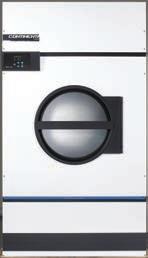












Contact Girbau Industrial for a FREE ESTIMATE to see how you can deliver more productivity to your laundry while increasing product quality! (800) 256-1073 • www.girbauindustrial.com INDUSTRIAL
Tools f the Trade
Company unveils flatwork ironer safety upgrade kit

A new flatwork ironer safety upgrade kit from laundry product supplier Tingue aims to help flatwork ironer workers by making removal of jammed linen safer and easier and by assuring that emergency-stop bars properly stop the belts when activated, the company reports.
Developed for retrofit on Super Sylon and other American ironers, the flatwork ironer safety upgrade kit integrates the company’s proprietary right-hand drive conversion and roll-raising rig with its UL-certified inverter cabinet to bring modern safety advances to aging ironers, says Tingue.
The right-hand drive conversion is programmed to respond instantly to E-stop activation by stopping the feed belts within 6 inches of travel to support compliance with OSHA standard #1910.262(c)(1) while allowing the machinery to stop with a coasting action that protects the sprockets, chains and other wear parts from damage, according to the company.
Tingue says that at the flip of a switch, the
Kannegiesser USA has launched a new folding robot, the company reports, available as FA-X 1200 Servo (for all garments in the hospital sector) or FA-X Industry 1200 Servo (applicable also for overalls).
The company says the robot can handle 950 to 1,200 items per hour, depending on article spectrum. A highly dynamic and precise servo drives the component’s hanger feeding, discharge of empty hangers, length folding wings and stacker.
Kannegiesser USA says the new folding robot has automated operation. Article feeding is achieved by special system hangers for folding robots, detachment of the hanger and the article, as well as transport of the empty hangers.

Other features the company highlights include:
raising rig raises the ironer rolls to allow jammed linens to be safely and quickly removed. Both the raising rig and right-hand drive are controlled via the company’s inverter drive cabinet.
Certified by the safety science company Underwriters Laboratories (UL), the inverter drive cabinet meets a growing variety of state mandates requiring electrical installations to meet the rigorous UL standards, the company says.
www.tingue.com 800-222-9954
• Folding of every article using one universal folding program.



• Automatic article identification.
• Shaft-belt principle in the cross-folding station and elastic mounted folding wings in the length folding station enable automatic thickness adjustment.

• High safety standard because of the constant positive article control.


• Continuous belting prevents jamming.
• Folded items are held in a perfect orientation due to the lifting stacker, which presses every article against a metal plate after the folding process.
• Precise function control because of item tracking.
www.kannegiesser.com 972-641-3153
The Pillow Factory division of Encompass Group wants to be a partner in infection prevention, starting with what’s resting under the patient’s or resident’s head, according to the company.
“Our trusted, high-quality pillow lines include varied, beneficial choices for patient care and protection,” says Michelle Daniels, Encompass director of marketing for The Pillow Factory. “Patients are provided the right balance of comfort and performance.”
Current Pillow Factory products include DreamAngel® and Brilliance® pillows for launderable comfort and performance;
RevolutionaryCARE®, Easy Care® and Comfort Care™; CareGuard® Plus and Pro-Barrier® for fluid and stain resistance; and Fresh Start Personal Pillows for singlepatient-use providing maximum breathability and freshness.

www.encompassgroup.net 770-626-2061
Synavax , which provides nanoscience solutions for sustainability and energy efficiency, has launched a product for factories and facilities, like laundries, to insulate their boilers to both reduce energy costs and improve employee safety, the company reports.
Heat Shield™ EPX-H2O is a two-part water-based reactive prepolymer that provides thermal insulation and corrosion prevention for a variety of industrial insulation applications, according to the company.
Synavax says the nanoscience product is designed to withstand harsh industrial environments and provide an in-service, spray-on application with no cladding or covering needed.

According to Synavax, the coating can reduce hot surface temperatures to a safe touch range.
This reduction in surface temperature is often 150 degrees or more, with just a thin layer.
The company says the product also offers splash resistance to chemicals; is resistant to 98% sulphuric acid, ammonia, bleach, and other acids, bases, and fuels; and is hydrophobic and resistant to mold growth.
www.synavax.com 800-858-3176

8 OCTOBER 2016 | AMERICAN LAUNDRY NEWS www.AmericanLaundryNews.com
Fighting hospital-acquired infections one pillow at a time
New folding robot handles up to 1,200 items per hour
Product addresses energy efficiency at the heart of boiler, safety of employees
ALN_Tab_1-4_H.indd 1 9/1/16 11:55 AM
When dealing with laundry stains, your reputation rides on getting the outstanding results The Laundry Two deliver. RiteGo® laundry spray spotter quickly penetrates to absorb collar & cuff stains, perspiration, ground-in soil and more, all without brushing. Turn to Laundry TarGo® to remove any tough oil based stains that remain behind.
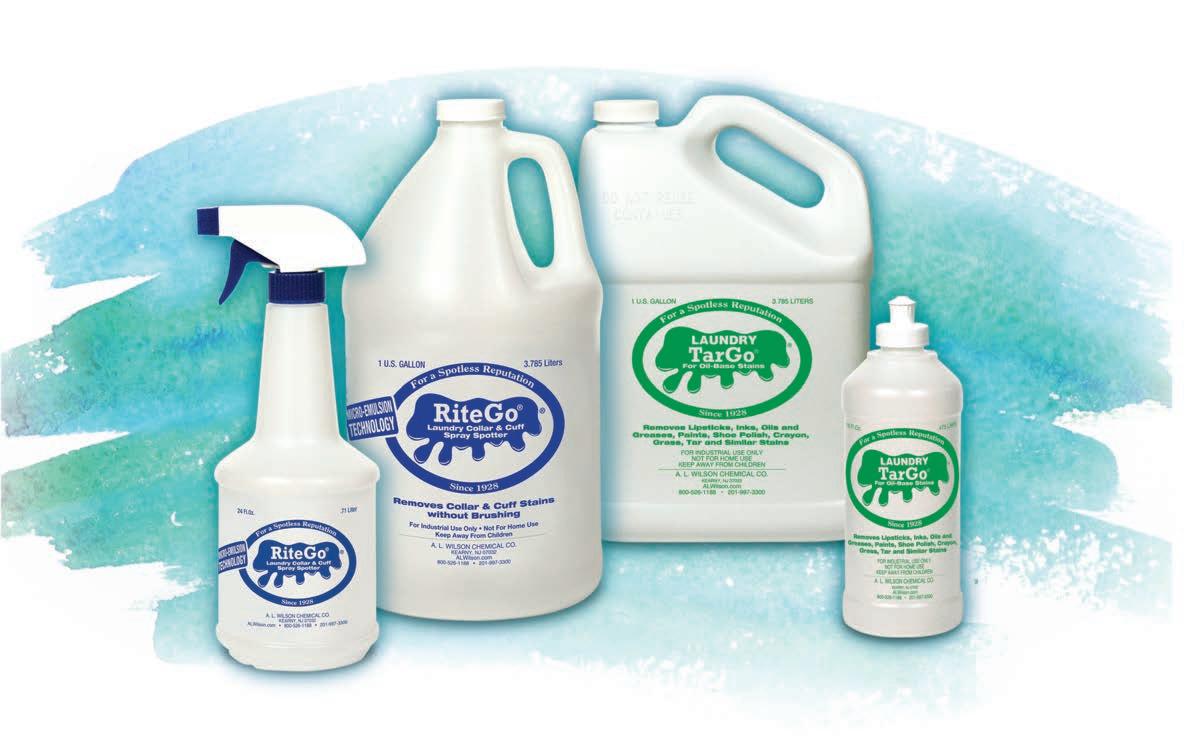
Use The Laundry Two with confidence on shirts, wedding gowns... anything you're washing or wetcleaning.
Both Laundry TarGo and RiteGo are chlorinated-solvent free, biodegradable, noncombustible and California 2013 VOC and Prop-65 compliant.
Use them to deliver stain-free laundry and wetcleaning. You'll build your reputation for quality - which is what keeps customers coming back.
FROM COLLARS AND CUFFS THE LAUNDRY T WO ™ ARE RIGHT FOR YOU! TO THE REALLY TOUGH STUFF... FROM COLLARS AND CUFFS THE LAUNDRY T WO ™ ARE RIGHT FOR YOU! TO THE REALLY TOUGH STUFF... To learn more, visit ALWilson.com or call 800-526-1188 A. L. WILSON CHEMICAL CO.
a STAIN WIZARD at ALWilson.com
Become
LINEN LOSS!
WITH FREE LINEN BRANDING

According to The Economist, between 5% and 20% of linens are stolen annually. Shrinkage is real, especially in hospitals and hotels where guests feel they have paid enough to justify taking a set of towels when they leave.

The truth is simply this: “A logo, whether it’s from the hospital or the company providing the linen, can be a deterrent for textiles to “leave” a healthcare facility.” - American Laundry News

We will help you stop linen loss while promoting your brand 24/7 with complimentary branded labels when low minimums are met.
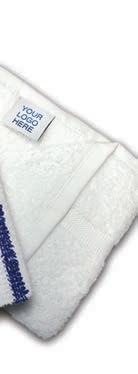
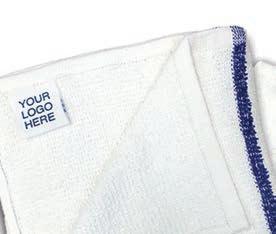
Stop linen shrinkage. Increase your bottom line. Gain control over your inventory. Call or go online to speak with a linen expert today.

ture top hospitality leaders, who will educate attendees on subjects such as travel trends, management, leadership and sales and marketing direction. HX: ONSTAGERESTAURANT will present chefs, restaurant owners and operators, and kitchen consultants and designers, covering what’s new and what’s next in the foodservice industry.
Not only does HX have a brand-new look and feel but HX: TECH is adding new interactive features this year to help enhance the attendee experience and educate about all the new tech gadgets, according to HMG.

hospitality and travel, and the HX: TECH Area and Stage are coming back in a big way this year, says HMG. The HX Experience team is expanding the offerings in the area from last year, and it will be the spot to visit during the show.
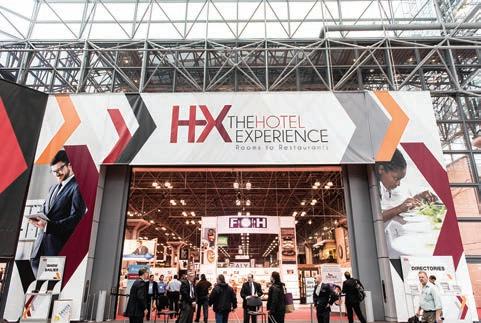
Dahlia El Gazzar, Tech Evangelist, DAHLIA+ and HX: TECH contact, says that HX will have lots of new and innovative ways to expand knowledge in the up-and-coming hospitality tech gadgets this year.
“Here’s what you can expect at the HX TECH area,” says Gazzar. “TECH Bar, where you can drop by to get tech help at the Tech Bar, and get answers and advice on all your tech and digital marketing questions.
Wearable Tech Showcase, where you can experience and play with wearable tech gadgets like VR gear, robots and more, and see how they will impact your professional and personal worlds right now. LinkedIn Corner & Headshot Station will allow HX staff to update LinkedIn Profiles and headshots for all attendees at no charge.”
HX will also feature all-new technologyfocused sessions and speakers that will help build knowledge about issues facing the hospitality industry and new ways to expand a hotel’s technology base to help create a better guest experience.
In addition, HX is adding a brand-new, live demo section to the show called HX: COOKS that will include some of the top chefs in the industry.
EXPANDING TECH
HX: The Hotel Experience is expanding on technology and digital marketing for

Companies conducting the sessions include MasterCard, Google, Marriott Hotels & Resorts, Interstate Hotels, IHG, Maidbot, Hotel Business and more. Some of the topics that will be covered at the HX: TECH stage include:
• Challenges & Solutions in Hospitality Cybersecurity
10 OCTOBER 2016 | AMERICAN LAUNDRY NEWS www.AmericanLaundryNews.com
(800)
monarchbrands.com
STOP
333-7247
can meet with
related to the laundry and linen industry. HX: The Hotel Experience is entering the second year of its rebranded show. (Photos: ST Media Group)
CORNER & HEADSHOT STATION WILL ALLOW HX STAFF TO UPDATE LINKEDIN PROFILES AND HEADSHOTS...”
Continued from Page 1 HX Attendees
exhibitors
“LINKEDIN
GAZZAR, HX TECH CONTACT
—DAHLIA EL
• The Future of Mobile Payments in the Hospitality Industry
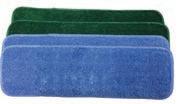
• 10 Ways Virtual Reality Will Change Your Guest Experience
• A Glimpse of Robotics in the Hospitality Industry
• Top Digital Marketing Trends & Tactics for the Travel & Hospitality Industry
• Mega Trends Impacting the Travel Industry

• Productivity Apps That Work for You & Your Teams
Lastly, HX: TECH will be hosting its second annual TECHpitch Competition. This allows HX technology exhibitors to showcase their unique products in a 15-minute presentation, with the winner chosen by HX attendees. The winner will be announced from the HX: TECH stage on Tuesday, Nov. 15.
RESTAURANTS AND COOKS

For 2016, HX: The Hotel Experience and the New York City Hospitality Alliance have formed a partnership through which the Alliance will produce restaurant and foodservice content for the show, says HMG. The Alliance will create and present sessions for both HX: ONSTAGE-RESTAURANT, the show’s on-floor center for foodservice education, and chef demos at the new HX: COOKS, the show’s culinary theater.
The New York City Hospitality Alliance represents 2,000 members made up of restaurant and nightlife establishments across all five boroughs and plays a critical role in meeting the specialized and unique needs of these essential pillars making up New York City’s identity, according to HMG.
“We’re thrilled to partner with HX to discuss today’s hottest trends and topics in the hospitality industry. We’ll bring together some of the most influential names in the industry to dish on topics ranging from tipping to mobile technology. If you’re in the hospitality industry, you will not want to miss this year’s show, I assure you,” says Andrew Rigie, executive director of NYC Hospitality Alliance.
“Whether it’s sessions for HX: ONSTAGERESTAURANT or demonstrations at HX: COOKS, we know the creativity and talent of the Alliance’s diverse membership will bring relevant, thought-provoking content to attendees,” says Robinson.

SPEAKERS AND SESSIONS
HMG says that the session lineup for HX: The Hotel Experience 2016 is taking shape, and will be educational across the board.
“HX session attendees keep up with trends and make smarter business decisions, and our three on-floor stages—Hotel, Restaurant and Technology—help attendees focus on the topics most relevant to them,” Robinson says.

Session highlights at HX:
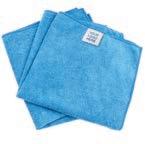

ONSTAGE-HOTEL
• Hotel CapEx: What’s in Store for the Next 18 Months & What it Means to Your Business—Hear an all-star panel of International Society of Hospitality Consultants (ISHC) members discuss the impact of the current hotel cycle and its implications.
• Behind the Numbers: What Two
www.AmericanLaundryNews.com AMERICAN LAUNDRY NEWS | OCTOB ER 2016 11 Minimums apply Promote your brand 24/7 with FREE logo label embroidery! • Personalized microfiber products, terry towels and bar mops • Ultimate control over your inventory • Carry your own product line • Free advertising for your business CUSTOM SOLUTIONS (800) 333-7247 monarchbrands.com MICROFIBER CLOTHS • 16”x16” professional microfiber cloths • Use for wet or dry cleaning • Wide variety of colors 35¢ POCKET MOPS • Highly absorbent 18” side pocket mop • Industrial strength canvas backing • Matching hardware available $2.65
WET MOPS • Cut cleaning costs without sacrificing quality • Commercial quality microfiber looped flat mops • 18” long with Velcro backing 95¢
ECONO
HX: ONSTAGE-HOTEL will feature sessions with top hospitality leaders.
See HX on Page 12
The 2016 edition of HX: The Hotel Experience will host more than 400 exhibitors on the show floor.
Leading 2016 Surveys Say About Sustainability Trends— Discover trends and innovative best practices from two leading industry surveys.
• STR presents the 2016 Lodging Survey, featuring topics ranging from energy management sensors to recycling programs to electric vehicle charging stations.
• Greenview presents the Green Lodging Survey, including results of “green” questions never before posed to hoteliers.

• STR’s Lodging Industry Trends—Join STR and learn how industry trends, outside influencers and potential disruptors will impact hotel performance in the future.
Session/competition highlights at HX: TECH, sponsored by MasterCard
• New Consumer Mega-Trends
Reveal the Future of GX— Sabre Hospitality Solutions explores mega-trends defining the future of business and consumerism and how they are impacting hospitality and the guest experience
• Plus, engage with the winner of TECHPitch, whose innovation may change the way hotels do business.
Session highlights at HX:
ONSTAGE-RESTAURANT
• Three of eight sessions developed by The New York City Hospitality Alliance explore how top trends can impact your business—and help it grow.
• Rooms to Restaurants offers an insider’s look into how food and beverage are enhancing the hotel experience.
• PR & The Digital Age answers questions about social media’s influence on your business.
• Tech in the Fast Casual Boom discusses in-depth how the fast casual restaurant segment is using technology to streamline their operations and scale their concepts.
Returning to the show floor from 2015, HX: Connect will be where attendees and exhibitors can sit and meet face-to-face or just recharge from the busy show floor, according to HMG.
HX: Studio will utilize its space to interview top hospitality industry executives, speakers and exhibitors of the show.

With all-new environmental treatment, session areas, speakers, and event highlights, the multimillion-dollar renovation made a big impression on lodging and foodservice executives who were in attendance at HX last year, says HMG.

The group expects even more from 2016. ALN
HX Exhibitors
Following is a list of HX exhibitors that offer products or services of interest to those engaged in laundry/linen services:
• Averill’s Sharper Uniforms, Waltham, Mass.; booth 2349
• B&C Technologies, Panama City, Fla.; booth 3165
• Bib & Tucker Uniforms, New York, N.Y.; booth 3355
• Braun Inc., Syracuse, N.Y.; booth 2965
• Cawly Co., Manitowoc, Wis.; booth 1918
• Chadsworth & Haig, Pageland, S.C.; booth 3061
• Chicago Dryer Co., Chicago, Ill.; booth 3055

• CleanBrands LLC, Warwick, R.I.; booth 3063
• Cuddledown, Yarmouth, Maine; booth 3137
• First Preference Products, Hudson, N.Y.; booth 2473
• Fresh Wave IAQ, Long Grove, Ill.; booth 2959
• GBS Enterprises, Sutton, Neb.; booth 2543
• GFL USA, New York, N.Y.; booth 3231
• Harris Pillow, Beaufort, S.C.; booth 2964
• HD Supply, San Diego, Calif.; booth 2745
• JS Fiber Co., Statesville, N.C.; booth 3346
• Kartri Sales Co. Inc., Forest City, Pa.; booth 3337
• P&G Professional, Cincinnati, Ohio; booth 2419
• Pellerin Milnor Corp., Kenner, La.; booth 3057
• Professional Laundry Systems, Deer Park, N.Y.; booth 2669
• Sassafras Enterprises Inc., Chicago, Ill.; booth 2244
• Say Yes Hotel Supply, Chandler, Ariz.; booth 2960
• Sintex Sales USA, Woodland Hills, Calif.; booth 3369
• Smart Step Flooring, Troy, Mich.; booth 2768
• Summit Appliance division of Felix Storch Inc., Bronx, N.Y.; booth 2765
• UniMac, Ripon, Wis.; booth 3267
• Welspun USA, New York, N.Y.; booth 3333
• White Towel Services, Fort Worth, Texas; booth 2544
• Xeros Inc., Manchester, N.H.; booth 2437
but we knew the end result would pay off,” Wesson says. “We dealt with it. We added in a little more staff to take care of the laundry from January to August.”
POND OPERATIONS
would take some product across campus to there every day. We have a baseball facility that is a few hundred yards away, and we’d take product out there.”
He says that the laundry facilities in those two locations are about half the size of the Pond, so it would be a full afternoon of laundry for student managers.
“It was a little bit of a challenge,

The payoff is a laundry room that can process all of the program’s laundry quickly.
“We’ll collect the athletes’ laundry in the locker rooms after workouts,” says Wesson. “Once a laundry cart is full, we will bring it over and we’ll start it in the washers. Usually, one cart equals two washers. We start that and get that
rotation going. In a matter of an hour and a half, we can have one cycle complete, and we will take it and put it back in the lockers.”
On a game day, Wesson says staff used to have to spend three or four hours, two to three different cycles, to do uniforms, pants, coaches’ laundry and athletic trainers’ towels.
“We were there half the night,” he says. “Now, our plan is we can actually load it all at once and complete it in an hour and a half.”
Wesson says that everyone in the football program, from the players to the coaches, use Laundry Loops
to ensure each individual receives his laundry.
The Laundry Loop is a strap with the number of the player or staff member on it. Each piece of laundry also has the number of the individual on it.
“If for some reason the laundry would come unattached, or maybe it wasn’t put together correctly, every piece of apparel that they have has their number heattransferred on it,” Wesson says. “So, if a T-shirt comes off or a pair of shorts comes off that Laundry Loop, it’s easy to recognize.”
At press time, the Ducks had
played their first two home football games (wins over U.C. Davis and Virginia), and Wesson and his staff experienced their first gameday laundry processing (which he says went according to plan).
“This new space streamlines our equipment operation, allowing us to service the student-athletes and staff in a much more efficient way, while also highlighting the unique Nike product Oregon is known for,” he says.
Wasson is still a busy man, but at least the Oregon football team’s laundry is processed more quickly in the Pond.
12 OCTOBER 2016 | AMERICAN LAUNDRY NEWS www.AmericanLaundryNews.com ALN_Tab_1-4_H.indd 1 2/2/16 9:51 AM
Continued from Page 11 HX
Chef demos will take place at the new HX: COOKS, the show’s culinary theater.
Continued from Page 6 Oregon
ALN
Selecting the right machines to speed up laundry and save labor is simpler with ADC. Our EcoWash lineup o ers a range of equipment choices, including rigid- and soft-mount machines with load capacities up to 60 lbs. and water-extracting performance up to 350 G-Force on most sizes. And all EcoWash models feature full stainless-steel cabinets. Because we’re as serious about making things last as we are about making you productive. See adclaundry.com for complete warranty details.

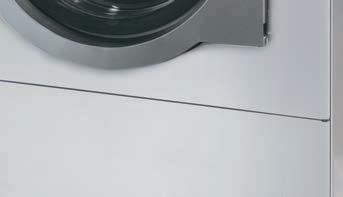



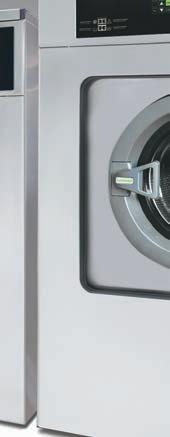

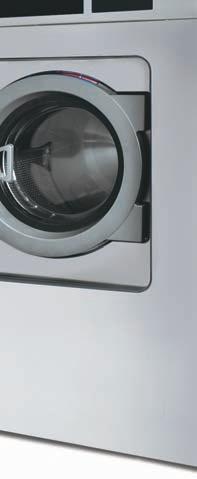


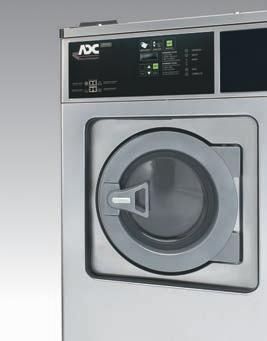

delivers productivity-boosting options.
The EcoWash lineup
Get the labor savings you need. And the size you want.
Financing as low as 1.49% for 12 months. Low fixed financing rates, terms up to 60 months available. Subject to credit approval and individual’s credit profile. This promotion is valid through December 31, 2016. 508.678.9000 | www.adclaundry.com
Managing utilities to reduce usage, save money
them when it was going to be time to do some maintenance on those pieces of equipment.”
BY MATT POE, E DITOR
CHICAGO — The key performance indicators (KPI), also called metrics, in the laundry industry are labor, inventory and utilities.
Each of those metrics can be positively affected to make improvements in the bottom line of a laundry business. When it comes to utilities—electricity, water and natural gas—there are practical steps that a laundry can take to see lowered usage and increased savings.
David Bernstein, president of Lapauw USA, addressed the topic of improving utility usage in the Association for Linen Management (ALM) webinar called Key Performance Indicators in Utility Management
“As we talk about utilities in our facilities, we’re going to answer some specific questions in regards to each of these utilities. How and what should I track? How much do I use? How much does it cost? What can I do to positively impact those metrics?” says Bernstein.

HOW TO TRACK
Bernstein says that the first thing a laundry needs to do when it comes to utility management is to set a benchmark.
He recommends that, every day, laundries have somebody in the facility go out to each of the meters for each utility. Take meter readings at the same time every day. Write them down, and at least weekly put them into a spreadsheet to start tracking usage, based on pounds processed on a daily basis, he says.
“Going out and taking readings is a very important thing to do because you only get your utility bills, and when you get your utility bill, unless you’re taking meter readings, you’re at the mercy of your utility company,” he says.
He says that laundries that take meter readings can compare those readings against the utility bills.
Beyond looking at meter readings for the entire facility and the utility bills, Bernstein says laundries also have the opportunity to put meters on individual machines.
“I was in a plant in Texas where each of their dryers had an individual gas meter so they could track on a dryer-by-dryer basis the efficiency of those machines,” he says. “Maintenance was able to use that as a leading indicator to tell
Bernstein notes that there are many automated systems on the market, and there are several companies that will not only go out and monitor the productivity of the plant, but can also monitor utility usage in a plant. In addition, there are centralized systems that can be installed in a plant.
“There are a lot of ways you can track, but the main thing you should be doing, in my opinion, is set up a spreadsheet so you can track exactly at the same time every day your meter reading, so you can track what your usage was from day-to-day, month-tomonth and year-to-year,” he says.
WHAT TO TRACK
What is it that a laundry should be tracking as it looks at each of these types of utilities?
“We have demand and we have usage and we have the KPI we’re going to look at to determine the health of our facility. KPIs are really no different than when you go to your doctor’s office,” says Bernstein.
For electricity, he says that on the demand basis, a laundry is going to look at kilowatts.
“You have peaks and you have valleys, and over time you end up using a certain number of kilowatts, and so the usage, what you see on your electric bill, is those kilowatt-hours, that’s the usage of kilowatts over time,” says Bernstein. “And that leads us to the important metric when we talk about electricity: kilowatt-hours per pound.”
The metrics are similar when it comes to tracking water and natural gas usage. For water, the demand is gallons per hour, and the key performance indicator is gallons per pound. For gas, Btu is the demand, Btu per hour is usage, and Btu per pound is the key performance indicator to look at.
TRACKING AND INFLUENCING ELECTRICAL USAGE
For each utility, Bernstein recommends carefully examining the bill received. On the electric bill, a laundry will see two entries: demand and usage. Usage is the amount of electricity used over time.
“Then you’ve got the demand charge,” he says. “Your electric company is going to monitor those peaks and valleys in your request, if you will, for power. For instance, if you start up a motor and your motor doesn’t have an inverter or a variable-frequency drive, it’s going to require a large inrush of current to get that motor running. If you have a bank of motors, a bank of
washers, let’s say you start all of those washers at the same time and then at some point, they all go into extract at the same time, those motors are going to be requiring a lot of power all at once, so the demand for electricity looks to the electric company to be very, very high. Your demand charge is based upon how much electricity you try to use in a very short period of time.”
Bernstein’s first piece of practical advice to lower the usage of electricity is for laundries to stagger startups. By staggering equipment startup, a laundry’s demand to the electric company will appear to be lower, resulting in a lower demand charge.
Also, a laundry will see on its bill, as well as on the meter, something called a multiplier or a correction factor. Bernstein says laundries need to know what this is on order for their tracking numbers to come close to what the utility company is going to charge.
“Knowing these metrics allows us to create charts to look at our usage over time to figure out why you are using more electricity,” he says.
How much electricity a laundry uses depends upon several factors, says Bernstein.
“The kind of equipment you have in use, for example, if you have a vacuum soil-sort system, that’s a lot of motors creating quite a few horsepower in order to move product from one place to another,” he says. “Your washer-extractors, depending on how many motors they have. Air compressors are a big user of electricity in facilities. Older lighting, you may find there is a very fast return on investment for replacing older lighting with high-efficiency lighting.”
Another way a laundry can save money on electricity is rate
mitigation.
“You may recall a few years ago in California, they had rolling blackouts,” says Bernstein. “There simply wasn’t enough power to meet the summertime demand. So they went to industrial users and said, ‘We’ll make you a deal, if you will switch your hours to our low-demand off-peak hours for electricity demand, we’ll give you a discount for every day that you do that.’
“There was a large healthcare launderer in the L.A. basin who did take advantage of that. They switched from a daytime shift to an evening shift and they saved a lot of money.”
Another way to possibly save money, Bernstein says, is for a laundry to verify that it’s on the right rate schedule. He says that if a laundry hasn’t spoken with a utility representative for a while, call and have him or her come in and make sure that it’s being billed on the right rate schedule.
“Maybe when you opened your facility, you were only doing 3 million pounds. Now you’re doing 8 million pounds,” he says. “It’s possible that there may be some discounts and incentives because now you’re a larger user that you’re not taking advantage of. This goes for electricity, gas and water.”
Bernstein says that there are several other simple ways for a plant to reduce electricity usage. Turn off both lights and equipment when not in use, and load washroom equipment properly.
Finally, Bernstein stresses that with all three utilities, proper maintenance is always key.
“People know about lubrication and belts and all of those kinds of things, but what some people don’t realize is even loose electrical connections actually use more energy than really tight and clean electri-
cal connections,” he says. “That’s something that your engineering staff should be checking on a regular basis.”
TRACKING AND IMPROVING WATER USAGE
Bernstein says there are two components to a laundry’s water bill: incoming, or how much water a plant is feeding into its equipment, and outgoing, or how much water the laundry is putting down the drain.
“Think about what your ironers and dryers are designed to do,” he says. “They’re designed to evaporate water. If you’re currently paying one-to-one on what comes in and what goes out, whether you have a water reuse or water recycle system doesn’t matter. We know that we are evaporating moisture. You should be getting evaporation credits from your utility company.”
Bernstein says that some laundries have been battling their utility companies for evaporation credit, and he recommends to keep at. In most places throughout the country, most people are getting evaporation credits, he says.
“Some get them automatically,” he says. “Sometimes it’s just a phone call, ‘Hi, I’m a laundry,’ and you get a 15 to 20% evaporation credit. In other cases, you may have to do some evaporation studies, but it’s well worth it because you’ll see that recurring savings month after month.”
A laundry’s water usage is measured in pounds processed per gallon, and Bernstein says there are a lot of dependent factors when it comes to usage.
“It depends on your equipment,” he says. “Do you use washer-extractors or are you using tunnel washers? If you’re using
14 OCTOBER 2016 | AMERICAN LAUNDRY NEWS www.AmericanLaundryNews.com
See UTILITIES on Page 18
specific questions and taking action is key, according to expert
Answering
(Image licensed by Ingram Publishing)

















IF YOU WANT YOUR LAUNDRY TO RUN LIKE A WELL-OILED MACHINE, YOU NEED TO PARTNER WITH ONE. UNIMAC® LAUNDRY SOLUTIONS AT YOUR SERVICE. When you replace your laundry lineup with new UniMac® equipment, you get more than just durable, high-performance machines. You get a total laundry solution designed to make and keep your operation running at peak efficiency. Our global network of distributors is always by your side to answer any of your questions. Our expert team of service technicians with over 4,500 years of combined experience will help you keep your machines up and running. And when you’re ready to upgrade, UniMac Funding makes financing your equipment fast and easy. Because it takes a well-oiled machine to know one. Find your certified UniMac sales technician at UniMac.com/Service
Disposable choices for industrial laundries WIPERS:
BY MATT POE, EDITOR
ALEXANDRIA, Va. — It’s estimated that the North American wiper market is $2.8 billion, says Larry Groipen, owner and president of ERC Wiping Products Inc.
Groipen attended the World of Wipes International Conference in Chicago this year and learned how big the market is.
He also found out that 51% of the market is held by the nonwoven sector, while 31% is held by shop towels and 11% is cloth rags. That means industrial laundries have options when it comes to supplying wipers to customers, and while reusables are the norm for industrial laundries, disposable wipers present added service and revenue streams.
Groipen talked about wiper options for industrial laundries during a Textile Rental Services Association (TRSA) webinar, Reusable & Disposable Wipers
REUSABLE RULES
Before going into disposables options, Groipen says that the reusables market is strong and vital.
“It’s a little contradictory because I just said nonwovens are bigger than rentals, but to my mind, rentals continue to dominate the industrial sector,” he says. “The reason for this is convenience.”
Many of the industries that use shop towels have been using them for many years, he says. It’s expected that when someone goes from one machine shop to another or from one automobile dealer to another, they’re going to be handed a rented shop towel.
Groipen says that rental wipers are preferred because the low cost of rental versus the sticker shock a client experiences when they get an invoice for cases of disposables.
“I liken this to the water delivery that we have at our company,” he says. “They bring the bottles of water, and we just pay it. It’s a natural bill. We don’t question it. and that’s very similar to the people I’ve talked to who rent shop towels. They are very convenient and very economical.
“I personally have never been able to talk someone out of rentals in favor of disposables.”
WHY AND WHEN WOULD A LAUNDRY OFFER DISPOSABLES?
While reusable wipers will continue to be used in many industries, there are reasons and times when it would make sense for a laundry to offer its client a disposable product.
Customer abuse, damaging of product (shop towels, kitchen towels, washcloths or other hospital textiles), is a reason to offer disposables, Groipen says.
Sometimes clients use the wipers in ways they’re not made for, or they’re used in an industry that happens to be abusive in general.
“You’d also want to consider when somebody is wiping something, getting some kind of a substance on your towel that you can’t wash out or it’s very difficult to pass on to a different end-user,” Groipen says.
High linen loss is another reason he cites. A laundry might realize that a customer is no longer profitable for the laundry because they lose too many towels.
“Some of these industries could include service vehicles, where the technician doesn’t bring them back at the end of the day,” says Groipen. “I know from personal experience, we have a fork truck company that comes and does the maintenance, and I would say 50% of the time, the guy leaves a dirty rag behind. So that would be a good account that you might want to consider not renting to them anymore.”
Then he points to a simple lack of accountability on the customer’s part. Groipen says he has been in large boatyards where shop towels are lying in puddles of water, and factories where employees don’t bring the wiper back to the stockroom or the appropriate place. Those are clients that a laundry might consider offering disposables to.
Sometimes, Groipen says, a customer has a wiping application that requires a non-standard wiper. Odd sizes are required, or the customer needs a lint-free option.
“In some cases, it’s a sanitation issue,” he says. “The laundry is sanitary and the processes are kept in order to deliver clean product, but when it’s actually in use, you’re no longer in control of that. The customer could leave a towel lying around and develop mold, or what have you.
“There might be an area or industry or customer where sanitation and hygiene is a factor. There are wiping applications where it would be bad for any kind of residual substance left on a shop towel that hasn’t been completely cleaned. Some of those would be electronics, sensitive surfaces that people are wiping.”
Another unique need Groipen mentions is absorbency. A customer may need more absorbency than a shop towel provides, and others are looking for less.
“But probably one of the bigger ones is the eye appeal and the perception,” he says. “Say you’ve got a food plant, pharmaceutical company, a healthcare facility, a medical device manufacturer, bringing inspectors through, bringing customers through, and the visual aspect of a rented item may not fit the bill.”
Groipen says environmental concerns at a laundry facility is another reason. There are still customers and industries that use some harsh chemicals.
“I think we’re all fortunate that they’re coming out with new chemicals all the time that are environmentally friendly, but in the meantime you still might have those in your customer base which could cause you problems in going over your discharge limits or having complaints from either your drivers or your laundry personnel,” he says. “Basically, the economics of a disposable outweigh the economics of a laundered towel because of these environmental issues.”
Disposables might have a positive effect on difficult accounts, Groipen says. The laundry might be able to save an account that’s not happy with the current situation.
“It’s very possible a new person comes in and he doesn’t like these things anymore,” he says. “He’s still happy with his uniforms. He’s still happy with his mat service. He may be happy with his restaurant service. Some reason or other, the customer says, ‘I’m not happy.’ By having disposables in your offering, you can save that customer.”
Groipen also says disposables might be able to open up an account that might have previously been unwilling to considered laundered towels. This could be especially true of cleaning industries that a laundry has avoided or been unsuccessful with.
There are additional opportunities in an account or a prospective account that wants to use the shop towel in one area, but they want to distinguish a wipe from one department to another, says Groipen.
“For example, they could be using the shop towels in a mechanical maintenance area, and in the quality control lab, they might want something that’s lint-free or looks better on the bench,” he says. “You don’t want to get caught up in the fact that you’ve always done rentals and that disposables are the enemy. The reality is both laundering and disposables have something that speaks to you, which is reoccurring revenue. Everything that’s thrown away has to be replaced.”
By offering more, Groipen says, an industrial laundry enhances its value by being able to go in
and drop off or maximize each stop with multiple opportunities by offering shop towels, uniforms and some kind of disposable that the customer requires or that the laundry wants them to use.
WHAT DISPOSABLE OPTIONS ARE AVAILABLE?
Several disposable wiper options are available, and Groipen says the first option is the rag.
This type of disposable is basically made from recycled clothing, cut-up T-shirts or cut-up flannel shirts, or new materials.
Cheesecloth is good for polishing or cleaning sensitive surfaces such as Plexiglas®, he says.
Groipen says packaging options for rags are pretty much unlimited, but the standard would be 5-, 10-, 25-, and 50-pound boxes. Some clients prefer pressed bags because they take up less room.
Groipen is a firm believer in using smaller wiper packages to overcome any price objections.
“For example, if you wanted to supply a 50-pound box for $100, you’re going to get some pushback,” he says. “But you could sell 10 pounds for $20, and somebody will say, ‘Yeah, I’ll take five of those boxes.’ There’s your 50 pounds; there’s your $100. It’s so much easier for them to say I’m only paying $20 than it is to say getting that big box, that’s $100.
“I know it sounds a little nutty, but it’s so much easier and your markups can be so much higher the smaller the package that you offer.”
Groipen says that any industry that would want a larger wipe would be a good market for rags. As examples, he cites wiping stainless steel or big tanks, big equipment, things that a shop towel just might not be adequate for in terms of size alone. Also companies with off-site applications—companies that service vehicles, elevator repair companies—those kind of places have multiple locations at which to lose a shop towel.
The next type of disposables is paper and nonwoven wipes.
“Over the years, there have been tremendous strides and discoveries and created lots of different wipe options,” says Groipen. “When I started, the only option was called a chem-wipe, which basically was a tissue in a box. It was basically taking a bathroom paper towel, sticking some nylon netting into it and using it as a rag. They didn’t do so well up against any textile.”
He says that the factors that need to be considered with nonwovens and paper are strength (wet strength and dry strength), the absorbency and the hand feel.
“We all know that the shop towel has been the ‘holy grail’ of wiping. It’s the one textile that nonwoven producers have been trying to recreate for the last 35 years,” he says. “They’ve actually gotten close.”
Lint is a big factor in wiping, Groipen says, so the choices of nonwovens and paper have to do with how much lint a customer is willing to deal with. Another factor is cost. He says there are wipes that cost 3 cents each, and there are

16 OCTOBER 2016 | AMERICAN LAUNDRY NEWS www.AmericanLaundryNews.com
Reusables dominate but disposables offer added business options
(Image licensed by Ingram Publishing)
wipes that cost 23 cents.
A versatile and popular disposable is called DRC, which means “double re-crepe,” says Groipen. Manufacturers put the paper through a machine that will make it feel more cloth-like.
“It’s very absorbent and low in lint,” he says of DRC. “It has good wet strength, and there is some solvent resistance, the more common solvents. It can be used for wiping hands and face, so you see lot of DRC in the healthcare industry as a disposable washcloth. You see it in any kind of a transportation company. Utilities tend to like them as well.”
The next type, Airlay, has less strength than DRC, but it is soft and cloth-like, he says. It has a lot of options in terms of thickness. This type of paper/nonwoven is seen most often in healthcare as a disposable wipe, a disposable washcloth.
“You’d see it in foodservice as a napkin replacement. With a logo, you would see this in the bathroom of a country club or finer restaurant,” says Groipen. “In our case, we’ve had this made as a bath towel for asbestos removal companies or firefighters in the middle of the woods that just don’t have access to reusable towels. Airlay is usually more economical than DRC.”
The next option, says Groipen gets close to being the holy grail of shop towels. Spunlace disposables are stronger wet or dry, they feel more cloth-like, and when they are wet, they don’t feel like a piece of paper.
“They actually do feel clothlike,” he says. “They’re very absorbent and much lower in lint than DRC and Airlay. They’re solventresistant, including harsher chemicals that can be used in many industries. It’s probably the most versatile one, and the one you’ll have the least complaints about.”
Melt-blown polypropylene has no wood pulp or wood fibers to create lint, Groipen says. The material is extremely rubbery, with no edges to catch and scratch surfaces. This type also releases liquids, which is why they are seen in medical wipes used with bleach because the bleach doesn’t break it down, he says.
Presaturated wipes are often used for sanitizing and disinfecting, he says. This product is used heavily in the fitness market, along with medical and foodservice.
Finally, Groipen says there are “critical-task” wipes, cleanroom wipes—environment wipes.
“These are a little more tricky than the other ones,” he says. “This is really where the wiping application and the requirements set out by the environment you use it in are going to determine what’s successful and what isn’t. In general, from application to application, you need a lot of customer interaction to make sure you give them the right one.”
This type of wipes is manufactured and packaged in clean environments.
WHERE TO START
If an industrial laundry is considering offering disposable wipes, the obvious question is what customer to target.
“In my opinion, you start with your lost shop-towel customer, your lost bar-towel customer, because they were wiping at one point in time, chances are they are still wiping,” says Groipen “You just have to find out what they’re using.”
Then, he says, the laundry should look at abusive customers or customers with environmental issues. These clients are where
production managers say, “These accounts aren’t great. They cause us all kinds of problems.”
Finally, Groipen suggests going after previously unobtainable accounts. These are accounts that a laundry hasn’t had success with in uniforms or other types, but it hasn’t offered wipe options.
“There’s a place where you’re not cannibalizing, you’re not shooting yourself in the foot,” he says. “You’re just offering up new opportunities. Educate your general managers, your production guys, your service guys, let them know that there are oppor-
tunities everywhere within your customer base, your prospect base. The eyes and ears of your route drivers are going to tell you where those potential opportunities are.”
What’s the next decision a laundry has to make?
“‘Am I going to jump in with two feet, stocking and offering a limited number of wipes to start off with?’” he says. “Or, you could locate and work with a supplier on a customer-by-customer basis. This way, you’re not committed to anything. You could feel your way around it. If you wanted to,
you could pick an industry, say your area has a lot of glass shops. You may want to pick a wipe that’s really good in glass and go after glass.”
WHY INDUSTRIAL LAUNDRY IS THE RIGHT DISTRIBUTION CHOICE
There are several reasons why offering disposable wipes would be a good choice for an industrial laundry, says Groipen.
First, he says to consider the competition. The laundry is going
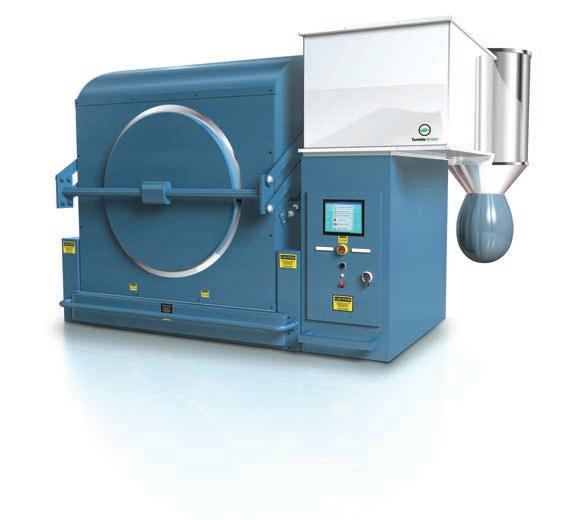
www.AmericanLaundryNews.com AMERICAN LAUNDRY NEWS | OCTOB ER 2016 17
See WIPERS on Page 19 UPGRADE YOUR CHALLENGE PACESETTER CLM leads the way in dryer technology and provides an upgraded replacement for your old Challenge Pacesetter Our Model 165 fits the Challenge Pacesetter footprint perfectly and gives you technology that no one else o ers, including a fully integrated production management system. • Upgraded heat system with improved efficiency and lower emissions • Micro-Command III PLC upgrade with LAN and Blue Tooth communications • PLC now prepared for flow process management systems • 2-stage variable speed basket drive with 3-port load door. • Soft start to reduce component wear, lower utility use. • Heavy-gauge basket, includes removable steel basket panels • Long-lasting ceramic coating available on removable basket panels. • Configurable exhaust location • Configurable control/burner location Call CLM to replace your Challenge Pacesetter dryers, or for information on our broad range of industrial dryers. 323-232-2417 Model 165 shown with Tumble Green® configuration See Us at Booth 2560 at The Clean Show 211 Erie Street, Pomona, CA 91768 | T: (323) 232-2417 | www.clmco.com ALN_Jr Page.indd 1 11/18/14 2:36 PM 0515aln_CLM.indd 1 4/13/15 4:46 PM
washer-extractors, do you have a traditional water reuse system. Do you have a water recycling system? Do you have a tunnel washer and a recycling system where, in some cases, you could be saving 70 to 90%, depending upon your product mix?”

Bernstein says the most obvious place to start when it comes to
reducing water usage is leaks.
“A little drip that keeps you up at night at home can cost you $140 to $150 a year,” he says. If that were my home, that would be something I would fix right away. If you go through your facility looking for little drips like this, they’re everywhere. Imagine if you could find, say, 10 of these. You’ve saved yourself $1,400; to me, that’s time well spent.”
Next, Bernstein recommends checking washer drains on a regular basis.
“I was in a facility that had a conventional side-loading washer-



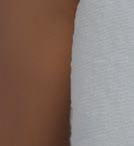
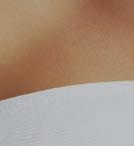


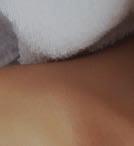
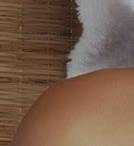

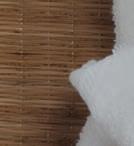

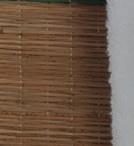




extractor with dump valves underneath,” he says. “So I got down underneath to look at these drain valves and what did I see? Napkins, strings, all kinds of things caught in the drains, which meant that the machine would fill up to a certain level and then because these drains were being kept open by all this stuff that was blocking the valves from closing fully, they were constantly leaking. They were constantly refilling.”
Not only was the laundry using more water than it needed to use, but it was also diluting the chemistry. Bernstein says the company’s
wash quality was probably suffering as well.
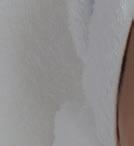

TRACKING AND IMPROVING GAS USAGE
When it comes to natural gas, the bill might read in Btu, but Bernstein says that some gas bills might read out therms or decatherms of McF. It’s just a conversion to figure out Btu used per pound in order to compare what the utility says has been used to the readings a laundry has recorded. Again, he says natural gas usage depends on the equipment in a facility.
“How many dryers? What kind of dryers? How do you use your dryers? Do you have ironers? Are they steam-heated? Are they selfcontained gas-heated? Are they thermal oil-heated where you have a thermal oil boiler elsewhere in your facility? If you have a steam boiler, what are you using it for? How large is it? How efficient is it? All of these things can affect your gas usage,” he says.
A simple way to reduce natural gas usage, says Bernstein, is for a laundry to check if the steam piping going from the boiler to, for instance, ironers, and the condensate lines going back, are insulated.
“Obviously, OSHA requires insulation within so many feet from the floor, but they should be insulated throughout your facility, especially if there’s a long distance involved. You could be talking about a lot of thermal loss before that steam ever hits the ironer,” he says. “You may be at 120 psi at your boiler, but once it gets to your ironer, you could be as low as 105 psi. You spent a lot of money to heat up water, and you’re not seeing the benefit; those need to be insulated.”
Bernstein also says that using heat reclaimers in a facility can help improve gas usage.
“For some plants, even water recycling systems can help with usage,” he says. “You can reclaim some of that heat so you don’t have to reheat that water before it enters your wash line.”
Another option to reduce cost is to look at how natural gas is transported to a laundry, Bernstein says. The cost of gas, he says, includes the commodity price, which is the traded value on the market. Next, there is a transportation cost, how much it costs to get the gas to the local municipality. Finally, there is the “city gate to burner tip” costs, which is how much it costs to deliver it from the city to your individual equipment.
“It is possible to use an energy broker. It is possible to use different transportation companies,” he says. “You don’t have to use your local municipal utility for each of those elements. By doing that, there is a lot of competition and you may be able to save just by using different people. You’ll get another bill, but who cares? You’re saving money.”
Other options to reduce natural gas costs, Bernstein says, include longer-term contracts and agreeing to what is known as “interruptible service.”
“Some utility companies will say, ‘We would love, with reasonable notice, say within 20 to 60 minutes, to be able to say we’re going to turn your gas off,’” he says. “Maybe it’s really cold weather, and the gas is needed elsewhere. If you agree to that, if maybe you have a supplemental propane tank onsite or maybe a gas-oil burner, you may be able to qualify for a lower gas rate from the utility company.”
Bernstein says there are several
18 OCTOBER 2017 | AMERICAN LAUNDRY NEWS www.AmericanLaundryNews.com
www.ecolab.com | 800.553.8683 | laundry@ecolab.com COMING SOON! $ LOW TEMPERATURE NON-CHLORINATED OXIDIZING WASH PROGRAM DESIGNED WITH INNOVATIVE, PATENT PENDING TECHNOLOGY TO MAINTAIN YOUR BRIGHTEST WHITES AND EXTEND THE QUALITY AND LIFETIME OF YOUR LINEN . ALN_Jr Page.indd 1 8/10/16 2:10 PM Continued from Page 14 Utilities See UTILITIES on Page 19
to compete with a distributor of wipes and rags, but those companies are usually distributing other things as well: janitorial supplies, toilet bowl cleaner, floor machines, industrial suppliers that have nuts, bolts, drills, screws, any kind of equipment.
“That’s who you’re competing with, but what is it you offer that they can’t?” says Groipen. “The first one is you can offer smaller quantities on a regular schedule. I can’t tell you how many times someone calls and says, ‘We’re out, I need it, do something.’ The reality is you know the schedule, they know you’re going to be there, and you’re used to dropping off smaller quantities of things.
“I’ve heard that somebody in the restaurant business can get one or two jumbo rolls of paper towels. They don’t have to stock the whole case. Here, you could take a case, break it open and sell by the package or roll. The industrial distributor, janitorial, the website distributor or Uline, they’re never going to break a case.”
Also, he says, the distributors have many products to offer. They’re not going to talk about wipes.
“That won’t be the first thing
Utilities
Continued from Page 18
ways a laundry can reduce gas usage. Keep the boiler tuned up. Monitor stack exhaust temperature to ensure efficient energy usage. Keep heating circuits clean as part of tune-ups. Bring the condensate from steam-powered equipment back to the boiler. Make sure the steam traps on steam equipment are in good condition. Make sure the burner and controls that are up-to-date and efficient.
“Consider a stack economizer,” he says. “You’re taking that exhaust air that normally would just go out in the atmosphere and make a nice cloud over your plant, and you’re using that hot air to heat incoming water.
“Inspect for leaks. A small leak, besides being dangerous, can cost you a lot of money. There are few plants I go through that have zero steam leaks.”
Most importantly, he says, the laundry needs to involve everybody in the facility to successfully reduce utility usage.
“Explain to everybody what the impact of leaks and drips and leaving lights on could be in the facility,” he says. “Explain the effect that each of them could have when making sure they save energy and keep their company profitable.” ALN
out of their mouths,” Groipen says. “The first thing will be equipment or chemicals, something that is probably more profitable, which is something they understand better. Whereas you’re necessary. Everybody needs what you’re delivering. You understand it. You have limited products so your people can speak much more direct than the competitors.”
Next, Groipen points to a reason to offer disposables that impacts the bottom line: smaller quantities equal larger margins. For example, if a laundry paid $40 for a case of nonwoven wipes with eight boxes
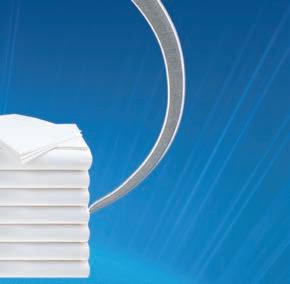
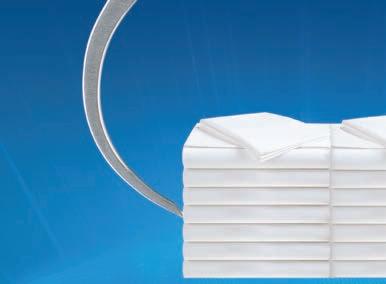
in it of 100 wipes, it’s paying $5 a box. If the laundry wants to double its money, it could charge $80. Or, make it simple and charge $10 a box, which sounds much better than $80 a case, he says.
“You can supply industrial wipes, disposables, it’s similar packaging that your customers are familiar with,” says Groipen. “If you’re already supplying bar towels or shop towels, you’re already considered an expert. If they have a question, they look to you and say, you know this wiping business. They look at the janitorial guy or the office supply product,
who can only know so much. You guys know a lot more than your competitors.”
Groipen says his favorite reason why industrial laundries are the right choice to offer disposables is that the laundry drivers have relationships in the back of the house that the industrial distributor and janitorial-sanitation distributor do not have.
“Laundry drivers know the people in the back of the house by first name,” he says. “They’re the eyes and the ears. When I was on the road, there was nothing better than a summer day when the back
door was open and I could drive to the loading dock and I could look in and then go around to the front. Hopefully, I could see something. You don’t have to worry about that because your guys are in there all the time.
“As we all know, people like to do business with people who they like. Those people are more willing to share, and your driver can ask them. They can see for themselves what’s going on there. They know that if they’re only dropping off uniforms to some kind of factory or production facility, there’s an opportunity in there.” ALN
Precision finishing,




any
way
you fold it. Revolutionize your laundry and linen business with Kannegiesser flatwork finishing. Our system includes an efficient multi-station feeder and highperformance ironer that handles linens measuring up to 158” wide. And our precision folder is capable of single- and two-lane folding and stacking, for a precise, Kannegiesser finish you can count on – every single time.
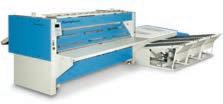
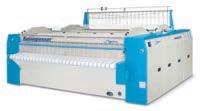
www.AmericanLaundryNews.com AMERICAN LAUNDRY NEWS | OCTOB ER 2016 19
kannegiesser-usa.com 800.344.0403 THE LEADER IN LAUNDRY TECHNOLOGY
EMQ 40
HPM II 40
CFM II 40 Precision Folder ALN_Jr Page.indd 1 7/5/16 3:54 PM
Multi-Station Feeder
High-Performance Ironer
Continued from Page 17 Wipers
Find equipment functionality edge with trained professionals
REASON 1: IN-DEPTH CERTIFICATION TRAINING
equipment support
BY BILL BROOKS
When it comes to on-premises laundry (OPL) operations, property and laundry room managers are always looking to maximize throughput and quality while reducing costs associated with labor, linen and utilities.
In order for a laundry operation to run at peak efficiency, the equipment needs to be properly maintained. If equipment is not running properly, it will have a significant impact on the success of the business.
Luckily, laundry room and maintenance staff are not alone when it comes to servicing and repairing equipment. Certified, factory-trained service technicians are only a phone call away and are ready to provide prompt and thorough service, no matter where you are located.
With their extensive training, vast knowledge of the equipment and access to the manufacturer, certified service technicians can provide OPLs with the peace of mind that their equipment will be tended to in a timely manner. Read on to learn why you should turn to a certified service technician the next time you need support with your equipment.
In order to become a certified service technician, a person must complete an extensive training program that is led by the original equipment manufacturer (OEM). The program provides technicians with a full understanding of the equipment and arms them with the professional skills needed to provide support and service.
For example, UniMac® offers a detailed online certification service training program for its distributor network. There are four different levels in the certification program, with level four having the more advanced classes. At each level, a service technician must complete the required online classes, additional elective classes and successfully pass an exam.
Certified technicians receive patches and an identification badge, which prominently identifies factory-trained service technicians. In total, the program has more than 100 classes available for service technicians. While all four levels of the certification program are not required, 69% of UniMac trained service technicians complete the level four certification.
Beyond the online certification courses, laundry equipment manufacturers have additional programs for service technicians to help them meet all of a customer’s equipment needs.
Andy Lubahn, UniMac product trainer, has been in the industry for 22 years and provides onsite three-day, in-depth training sessions that cover equipment installation, maintenance and high-end troubleshooting.

“The training is three eight-hour days and the curriculum is based off of real-life examples we learn about from our service technicians,” says Lubahn. “The program changes based on people’s specific needs, and with the product line changing over time, the training also changes.”
REASON 2: EQUIPMENT EXPERTS
Following the factory certification program, technicians will have a strong understanding of the equipment that ultimately helps them work more independently to complete the service needs and get in and out more quickly.
“A certified service technician speaks the language of that machine,” says Lubahn. “A general service technician will work on everything, and they may not be familiar with your equipment.”
Stan Hannibal, vice president of engineering for McKibbon Hotel Management, has many responsibilities across 85 properties. When it comes to the laundry operation, Hannibal is responsible for equipment selection, preventative maintenance and equipment replacement.
Hannibal has been in the hospitality industry for 30 years and through his experience understands the impor-

tance of working with certified service technicians.
“Oftentimes we have had general service technicians who do not always know what they are doing, which leads to more costs and equipment downtime,” says Hannibal. “I always look for certified service technicians because they are experts in the field and the equipment. They’ve been through the proper training and they know what should be done.”
With their extensive training, service technicians are specialists when it comes to equipment, and they give laundry room managers the confidence that the job has been done right.
“The certified service technicians we work with across our properties have so much knowledge on the equipment and they know exactly what they are talking about,” Hannibal says. “We have good working relationships with our distributors and I have a phone list with their contact information in each of our properties so that the staff can call the technicians if they need support.”
REASON 3: DIRECT ACCESS
The laundry manufacturer will continue to be a resource for the technician far beyond the certification completion. It is there to provide continued support to help technicians troubleshoot any equipment issues and provide ongoing online and onsite training as new products are released.
“Certified distributors have a direct link to the equipment manufacturer that they can turn to for help when needed,” Lubahn says. “This support helps resolve equipment maintenance needs more quickly.”
The manufacturer is only a phone call away and will work closely with a technician to address any problems they are experiencing. In addition to having field service managers and staff ready to answer a service technician’s call, they also have a number of online resources available.
“If a technician is onsite with a question, they give us a call and we have an answer for them right away,” adds Lubahn.
Certified service technicians will also supply OEM replacement parts. Equipment parts a customer secures from a distributor are specifically engineered for that equipment and have been put through testing to ensure proper operation. Another advantage is that certified technicians also know and honor manufacturer equipment warranties, which can be up to five years on some parts.
REASON 4: TRUSTED RESOURCE
Beyond equipment repair and maintenance needs, a distributor’s certified service technicians can help with other laundry room needs, such as training staff, evaluating an operation to identify inefficiencies and providing recommendations for when it may be time to replace outdated equipment.
McKibbon Hotel Management recently began working with its service technicians and manufacturer to implement a training program for laundry room staff throughout
multiple cities. The training provides education on the equipment to reduce machine downtime and operating costs.
“The training has increased the working knowledge of everyone in the hotel laundry room, which was one of our critical success factors,” says Hannibal. “An important part of the training is educating staff on when they should call a service technician for help.”
Additionally, your distributor and service technician can help make recommendations for when it might be more costeffective to replace outdated equipment. Today’s advanced equipment has more technology that reduces water and energy consumption, helping to save thousands annually on linen, labor and utility costs.
“Proper preventative maintenance will help maintain the quality of the equipment and extend the life,” says Lubahn. “But there is a point when businesses’ equipment is in the double-digit years and heavy mechanical replacement parts—such as the bearings, shaft and cylinder—are needed. That is when it becomes time to weigh the costs of those repairs versus the cost of new equipment.”
REASON 5: HELP REDUCE DOWNTIME
While there are many benefits to working with a certified service technician, one of the most important is efficiency when it comes to servicing equipment.
“The greatest value service technicians provide is time,” says Lubahn. “Any OPL needs to handle laundry processing as quickly as possible and reduce equipment downtime so that the property does not lose time and money.”
When working with a certified service technician, there is a higher chance that he or she will be able to find the cause of the problem and handle it in a timely manner, rather than someone who is not as familiar with the equipment.
“When non-certified technicians don’t know the products as well, they have to ask a lot of questions and it takes longer to fix the equipment, which leads to more equipment downtime,” Lubahn says.
An OPL plays a critical role in the success of a business, no matter what the industry may be, which is why it is important to have someone ready to provide quick and thorough service.
Knowing there is a trusted resource that is up to date on industry practices and is ready to help with all equipment needs provides a peace of mind for laundry room and property managers. ALN
Bill Brooks is North American sales manager for UniMac®, a provider of on-premises laundry equipment. To learn more about UniMac, visit www. unimac.com/opl101 or call 800-587-5458.
20 OCTOBER 2016 | AMERICAN LAUNDRY NEWS www.AmericanLaundryNews.com OPL 101
Five reasons to turn to certified service technicians for
Certified service technicians “speak the language” of the machine used by an OPL. (Image licensed by Ingram Publishing)
Brooks
Tracking: Numbers and actions
Minn.
For the purpose of this broad topic, let’s focus on service and outside sales. The KPIs (key performance indicators) we focus on with our clients are both activityand result-based. These are some examples.
SERVICE Retention
• Quit item percent of rental revenue.
• Quit account percent of rental revenue.










Growth
• Route sales average—weekly revenue.
• Inventory net revenue (increase vs. decrease).
• Net price increase: “Net” is the core measurement. This means you measure the total revenue price increase minus exempt accounts (contractual commitments, municipalities, purchase order accounts, national contracts, accounts that are exempted due to retention risks, etc.)
• Charge and cash credit percent of revenue.




Merchandise
• Uniform stockroom requested and issued percent.
• Net merchandise cost: Percent of new merchandise input dollars compared to total product group revenue.
Accounts Receivables: Some companies define this KPI as an office responsibility. Other companies consider it as a service function.
• Past due accounts (current, 30, 60, 90-plus days).

• Write-off dollars.
OUTSIDE SALES
Weekly rental sales sold.
Weekly catalog sales revenue sold.

Appointments/week

• First-time appointments, follow-up appointments.
Activities/week: On-site cold calls, phone prospect calls, e-mails, direct mail, referrals, etc.

ACCURACY
BrightLogic Diaphragm pump


LIMITED MAINTENANCE

www.AmericanLaundryNews.com AMERICAN LAUNDRY NEWS | OCTO BER 2016 21
ontact to co er t e ent re BrightLogic range o la n r en n te A Bright-Tech Investments Company www r twell nc co r twell r twell en er nc Meet us on boothOctoberChicago#402026-28
an e e w t t e o t a re e c e cal
CHEMICAL RESISTANCE
con
t l co ro ct
Excellent flow rate
tenc e en w
n a
an no c an e a e co t ALN_Jr Page.indd 1 9/6/16 9:26 AM
and
laundry
ntenance
PANEL OF EXPERTS “I’ve attended trade shows and webinars
have heard a lot about benchmarking and tracking. To ensure that the
I manage is achieving top production on an ongoing basis, what do you think I should be tracking and why?”
Consulting Services
Chris Mayer
See EXPERTS on Page 22
Performance Matters, Plymouth,
Proposals
We focus on a number of other KPIs with our clients and benchmark these specific results versus the overall laundry industry. This helps our clients identify areas of opportunity. You have to keep score if you’re going to win the game.
Okay, so you have established the metrics you want and you have a way of gathering the information. This begs the question: What do I compare my metrics to in order to determine if I am achieving my goal of high productivity? We know that even if we grow up in the same family, each member of the family has strengths and weaknesses that differ from other members of the family, even when there are twins or triplets.
In the laundry, the analogy is that every plant is different and will perform differently even when built by the same company with the same or similar equipment. Why? Because even though they are physically the same (definitely not the usual case), they have different utility, labor and supply costs. They have different people, and they operate under different laws.
These variables include, but are not limited to, the size, shape and state of repair of the laundry space; equipment type, quantity and state of repair; labor force availability and training level achieved; type of goods to be processed and quality level required; chemical supplier’s technical capabilities; and the list goes on and on.
Given that achieving and maintaining high productivity is the goal, I would measure labor, utility consumption, chemical supplies and output. I target these items to measure because they represent those items we can control on a short-term basis. I may not be able to control depreciation costs short-term, but I can certainly change washing formulas to use less water and chemicals.
The metric I would use for labor would be pounds produced per productive labor hour. Productive labor hours include everyone in soil sort, wash, flatwork, dry fold, garment processing and packaging—essentially everyone who works in the laundry and touches the linen. The output used for the productivity metrics should be clean, dry pounds packed and shipped.
Similar metrics would measure each utility (power, fuel, water) and chemical supplies (alkali, detergent, bleach, sour, etc.) against the pounds packed. Timing of the availability of these metrics is critical. Ideally, these metrics are automated and available to you in real time so that you can react to exceptions in performance as your day evolves. The longer it takes to develop and make available the metric data, the less time you have to react and take corrective action.
I’ve seen plants have the metric data available on their supervisor’s cell phones in real time, and I have seen plants that have it available on a daily, weekly, or monthly basis in a printed report. Can you guess which one has the highest productivity?
The answer to the question is to develop your own goals for each metric. You have co-workers, colleagues in other laundries, equipment manufacturers, consultants, chemical vendors, seminars, webinars—a whole community of sources you can tap to develop goals for each metric. These goals should be revised over time as you make process or equipment changes, develop new methods, train, etc.
Comparing your operating metrics against those of other plants can help you to understand where additional improvements can be made. To not set operating goals leaves you on the road to a destination without knowing where you are or when you have arrived.
to the success of your operation. They can make or break your efficiency times, so it is important that any tracking system and the “why” behind it is communicated effectively in order to get their buy-in and to ensure they have a reason to stay motivated to make it a success.
As you implement your tracking, remember to reward the performance of your employees. Talking about the rewards up front is just another reason for your employees to put their best foot forward. Reward efficiency. Reward outcomes. Reward good attitudes.
For the washers that you are using, you need to be aware of the load capacity of each, the length of the cycles that you are selecting, and that is it the best fit for the type of laundry that you are washing. The type of laundry will determine all of these questions.
Take a mental inventory and determine, “Is an extra rinse truly needed?” “Is hot water a requirement?” Be cognizant of the load size, as there is no reason to run an 80-pound washer for a 60-pound load.

Regardless of the type of laundry you are overseeing, whether it is a centralized commercial laundry operation or a drop-off service at a Laundromat, there are several key areas to be aware of for tracking purposes.
• Employees
• Machines
• Supplies
• Processes
Before tracking anything, take an honest look at your time, your level of commitment and your resources. Benchmarking and tracking are great if there is follow-through to actually utilize the information and make changes in your business. It is absolutely a waste of time if you only collect and never do.
To address the most subjective aspect of the operation first would be to take a good look at your employees. They are the key

The same thinking should apply to your dryer selection, as well. However, tracking for your dryers is not as pertinent as the washer tracking. Record what machines are used and the optimal cycles for each laundry job. This takes the guesswork out of it for the next time.
Your supplies should be chosen specifically for the needs of the laundry. Is the laundry medical in nature? Grease from food service? Diapers requiring a certain pH? A request for all-organic or chemical-free wash?
All of these needs can be accommodated easily by shopping the local bulk store or online. Buying bulk equals savings for you but it also means that you need to regulate the amount of the supplies used. Most detergents today are formulated for smaller portions to be used so it can save you money, but it’s important that your employees are aware of the correct amount, too.
You need to know how much of your supply is being used for each wash on a weekly or monthly basis. This allows for correct budgeting and planning.
Once employees are on board, you know which washers should be used and you have supplies available, it is imperative that you streamline your processes.
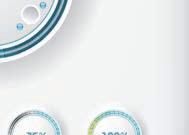


Employee efficiency will be determined by attitude first and understanding second. Understanding means having a clear-cut process of “how to” for the work and hands-on training to check for the level of understanding and ability of each person.
With the training in place, is the work area clean and easy to move around in? Streamline the mental and the physical processes. This removes any last impediments in your journey to success.
Lastly, know your numbers. If you don’t know and understand your cost to operate, including running machines, maintenance, salaries, building or rental costs and other ancillary expenses, you won’t know where to improve or what to leave alone. The tracking will tell you whether or not your efforts are working.
to period, enables one to establish a feel for individual operational production level norms, so that variations to the norm, up or down in the future, can be observed, evaluated and learned from (e.g., why have our resulting statistics changed negatively from period to another, or what happened, positively speaking, when we made what we hoped was a beneficial operational change over the most recent period?).
Specific data that has proven beneficial to operation management over time has included, but is not limited to, the following:
• Pounds of clean linen produced per period.
• Pounds of rewash as a percentage of total production.
• Rag-out (linen that is not reclaimable) as a percentage of clean linen produced.
• Pounds of linen processed per operator hour.
• Labor cost in dollars per operator hour.
• Utility costs (if able to be determined) as dollars per pound of clean linen produced.
• Linen replacement in dollars per pound.
• Total cost to produce a pound of clean linen.
• Hours worked without a lost-time accident.
By tracking these data, and either comparing these numbers to other “similar” operations, or simply monitoring same after operational modifications are made, the laundry manager can more effectively manage and direct the successful outcome of their individual operations.
I t is truly important to benchmark and track all operations via established metrics.

B






enchmarking and tracking operational data is key to proper laundry management.

National statistics, if not always best used as a definitive goal for each and every laundry operation, can serve at minimum as a guideline for managerial reference points in terms of laundry overview.
Even if national statistical benchmarks are unavailable to a laundry manager for comparison, tracking operational data from week to week, or longer period

All operations are not alike in product mix, finishing process, labor rates and utilities, but it is essential to establish numbers that can tell operators—on a daily basis—whether they are “on track” for profitability. At that point, operators can compare final outcome monthly and “reset” where necessary.

Let’s not forget, however, that successful production is based on more than just efficiency. There’s also product quality, complete fill rates, utility costs, labor costs and maintenance costs. That said, “efficient” operators typically track a number of key areas.
First, direct production labor costs—typically the total dollars as a percentage of related revenue. It’s important, however, that one
22 OCTOBER 2016 | AMERICAN LAUNDRY NEWS www.AmericanLaundryNews.com
Equipment Manufacturing
Diedling Pellerin Milnor Corp., Kenner, La.
Mike
Textiles
Steve Kallenbach
Continued from Page 21
Equipment/ Supply Distribution Todd Santoro CleanWash Laundry Systems Inc., Omaha, Neb. Chemicals Supply Scott Pariser Pariser Industries Inc., Paterson, N.J.
ADI American Dawn, Los Angeles, Calif.
Experts
(Image licensed by Ingram Publishing)
first establish “standards and rates.” Every item in the operation has a typical production standard rate (speed) that can be tracked.
If, for instance, you are finishing uniform shirts on a “Triple Connie,” the typical rate might be 180 pieces per hour per operator. Therefore, if you have 10,000 shirts per week in your flow, you have 55.5 hours of production at rate. And if your labor rate is $10.50 per hour, the cost of that production would be $582.75 that week.
Rates for every textile are easily obtained in the industry— through textile and chemical suppliers, associations and your network of peers. Establish “rates” for all items flowing through production, thereby establishing your weekly costs—based on exact hourly labor rates as well as the actual pieces running through the plant. That total dollar, backed into the related revenue, is your productive labor percentage. This percentage can vary greatly, depending on the market you are in, your product mix and your labor costs per hour.
An eye on overtime should also be applied. As operations grow, they typically experience overtime—until there is enough volume to add another production operator. By monitoring overtime, an operator can keep a keen eye on that timing. By monitoring production output by associate, based on established and posted rates, an operator can also understand best practices within departments and find production associates who need coaching, motivation or something else.
The second area to track is utilities, including gas, electricity and water consumption. The best published industry benchmark in this area is the Textile Rental

Services Association’s (TRSA) “Clean Green” program. While this is considered a model standard, most good operators in the industry should be able to make these benchmarks.
While I believe that production tracking (including utilities) should be done on a daily basis, the very minimum comparison goal should be weekly. There is no reason for a production manager to wait for the end of the month to understand how good or bad that month’s outcome was. Most great production managers track their numbers and know where
they stand daily.
Another area of tracking is in merchandise fill rates. Production operators sometimes struggle with having enough of a certain product in the system to fill the routes for the following day. Merchandise tracking is key in this area.
Each day’s numbers should include A) the number of units cancelled off invoices, B) the number of units added to invoices and C) the number of units ragged out on the finish floor. If you track these items and purchase new merchandise based on

invoiced growth (allowing for ragouts), and after that, you are still short, you have merchandise control issues. Merchandise is going out and not coming back.
While a discussion on this subject might be left for another day, it is vitally important for production managers to understand why they are short on merchandise, and the tracking formula described will assist in that.
While many operators track their key production areas, some respond to the outcomes differently. Certain operators will use the numbers to push their crew
harder, for faster production, for job security. Others will use it to motivate (through pay) faster outcome.
So, as a production manager, do you know all your standard rates by item? Do you know the expected cost of labor based on rate? Do you know the amount of energy and water you should be using based on weight? Do you track your overtime daily? Do you track your merchandise shortages daily?
All these measurements will ultimately lead to “efficient production” of textiles. ALN
www.AmericanLaundryNews.com AMERICAN LAUNDRY NEWS | OCTOBER 2016 23
New Technology Backed By Science = Dependable, Repeatable Quality Every Time! www.gabraun.com PRECISION SERIES FINISHING SYSTEMS ® ALN_Jr Page.indd 1 9/6/16 11:26 AM
because it will look like the ironer didn’t press it out.
“Often we’ll get involved when a customer lets us know they’re having a problem, and it’s just a matter of weighing some wet linen, get that linen dry, weigh that same 20 pieces or whatever and see what that percentage of moisture is,” Rovetto says. “You can’t go weigh 20 more sheets, because they’re newer, older or whatever. It has to be the same ones so we can get keyed in on what could be the problem.”
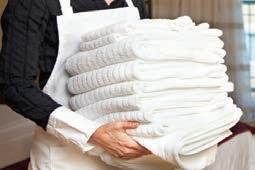
Rovetto had a customer where all of the ironers were running well but then ran a different color through the equipment. The client didn’t have the right moisture in the product when it went through the ironer, and all of it looked bad. Then they went back to white, and the ironer put out a quality product.
“Come to find out it was a different color that was involved that they don’t have a lot of inventory,” says Rovetto. “So, it’s not that we’re fixing equipment at that point, but sometimes that’s what we hear. ‘This ironer is great for everything, but it won’t run black mats. Whose fault is it?’”
IMPORTANCE OF FEED QUALITY
The ironer will only put out what it is presented, Rovetto says, so get it loaded properly. It’s important to feed the product into the ironer square along the lead edge.

“This becomes a challenge sometimes with automated feeders,” he says. “They’re great and save a lot of labor. You just have to make sure they work properly, get blown out, vacuumed, and the belts are good.”
Sometimes, according to Rovetto, a laundry may see that the product is fed properly but it’s off because something else starts slipping. The ironer will press it, but it won’t look as good.
“When there’s a problem with the product line for a customer, once I open up the bottom and see what kind of rejects we’re getting, I’ll go to the front and watch it all the way through,” he says. “Automated equipment is something to keep an eye on and keep it up to par and it will help.”
FUNCTIONING VACUUM SYSTEM
Rovetto says that most of his customers struggle with the ironer’s vacuum system. Whether it’s a new or old ironer, if it has springs on it, more than likely there is a vacuum system.

The vacuum system pulls moisture out, he says. By pulling the moisture out, the roll stays hot, promoting better drying and helping to maximize speed. Rovetto also says a vacuum system prolongs pad life because wet pads—it doesn’t matter what they’re made of—are not going to last as long.
Rovetto recommends cleaning the ducts annually. They should be taken off during downtime in order to make sure they’re not clogged.
“What happens is you have a wax mode, and you punch the wax mode when you wax your ironer, and that’s great,” he says. “Some ironers don’t have wax modes, and what happens is you start waxing it and you never turn your vacuum off and you get springs that rust.”
They’re going to rust over time, but clogging the ducts helps to speed that process up. The springs should last 15 years on equipment used during 40-hour workweeks, according to Rovetto.

“With a 40-hour workweek, you should not have to replace the springs twice on the same piece of equipment.” he says.

PROPER CHEST-TO-ROLL CONTACT
Chest-to-roll contact, this is something that Rovetto says is often an interesting
subject with a customer. The laundry is trying to get the most life out of its product. The ironer, in terms of maintenance, is saying it’s time to re-pad it, but the pads look good.
“They may look good from appearance, but it may no longer be good enough to give your press quality,” he says. “Your rejects may be creeping up, or your rewashes we’ll
www.AmericanLaundryNews.com AMERICAN LAUNDRY NEWS | OCTOB ER 2016 25
For over 50 years U.N.X. INCORPORATED has been involved in the development of products that not only solve quality problems that exist at the moment, but also provide long term benefits to the customer and the environment in which we live. U.N.X. was built on the foundation of improving the industry in which we participate. U.N.X. prides itself on being an industry leader with state-of-the-art products and dispensing equipment, and our plans for the future are extraordinary. With a Research and Development team second to none, U.N.X. is in a position to provide the industry with the most technologically advanced products and dispensers as possible. U.N.X. INCORPORATED 707EArlingtonBlvd Greenville,NC27858 (252)756 8616 www.unxinc.com ALN_Tab_half 10/9/12 2:40 PM Page 1 See us at the Clean Show • Booth #2502 0513aln_UNX.indd 1 4/26/13 10:48 AM ALN_Tab_half.indd 1 8/6/13 AM If an ironer’s vacuum isn’t functioning properly, the springs can begin to rust. See FLATWORK on Page 26
call it. Regardless of the appearance of it, the padded roll needs to fill up the chest. If the pad is too small, what you’ll see happening is you lose some drying capacity. You’ll also see your rejects increase.”
The typical thing Rovetto sees is that the ironer tape is pulling the product along instead of the roller pushing along the ironer
tape. Because the product is dragging, he says, little “crow’s feet” form on each side of the ironer tape. That means it’s time to pad the ironer.
Depending on the type of ironer used, some ironers will have a pad cover that goes on each row. The larger ironers just have a pad that serves as both.
“These pads will always lose when it comes to pressure,” Rovetto says. “When you do repad your ironer, make sure you go back to minimal pressure. That may be zero pressure and the weight of the roll takes care of running your ironer. If the qual-
ity looks great and it’s dry, that’s great.”
If a laundry goes back to using the pressure level from the day before the re-padding, linens could get scorched.
“They’ll never bounce back from that,” he says. “Also, when it comes to the pad versus the ironer chest, the pad will lose every time, and you’ll be prematurely having to pad your ironer. Wasting money.”

PROPER SPEED GRADUATION
There are different speed issues that should be addressed







on different pieces of equipment, Rovetto says. With a feeder, an ironer and a folder, there should only be a 2-3% speed graduation from each piece of equipment. Why? The purpose is to continue
It’s not just print anymore.
to keep the linen flat, pulling by the faster roll. The ironer should be turning faster than the feeder, and the folder turning faster than the ironer. That’s the way it should happen.
“You’ll know it when you see it because you’ll see, for example, your sheet won’t stay flat. It will be coming up,” he says. “It’s something that needs attention quickly because all of your ironer tapes will be coming off the chest.

“I always talk about speed because a lot of the places I go into, some people keep messing with the speed and crank it up, some people crank it down.”
He says that if a laundry has a 4- to 5-foot gap between pieces, turning up the speed isn’t going to get more pieces through.
“It’s just going to raise your rewash because you’ll have more rejects,” says Rovetto. “I’ve walked into some doozies in some plants where engineers and production were arguing about it. If you don’t keep product between your rollers and your chest, you’re just going to cook your pads and you’ll end up replacing them prematurely.”
If a machine is running faster than someone can feed, the numbers won’t be there. A laundry can still get the numbers it wants, with better quality and fewer rejects, if the ironer is slowed.

DRIVE ROLL COVERINGS


Drive rolls that turn the feed belts need to be covered, Rovetto says.
“They always should be covered with some sort of textile, something to get some friction so you can turn your belts. Otherwise, you get belts slipping; they get stretched,” he says. “You’ll have three to four in the middle just spinning, and you’ll add to your rewash.”
TROUBLESHOOTING QUALITY — BACK TO FRONT












Rovetto suggests having a troubleshooting procedure to check when quality drops on an ironer.
“We go straight to seven or eight of these things previously mentioned; we always check them out when a customer has an issue,” he says. “Doesn’t matter if it’s moisture, doesn’t matter if it’s wrinkles, doesn’t matter if it’s poor press quality, one of those will lead us, or a combination will lead us, to a solution.”
Rovetto says that there is normally more than one cause for decreasing ironer quality. It’s a matter of spending some time watching the product go through the plant, he says, while taking measurements.
“The easiest way is to go back to front, go to the beginning of the process,” he says. “The beginning of the process may be you washed it, but it showed up on the ironer because something happened to it after. Nevertheless, it’s going to show up on the ironer most of the time, unless it’s stains.”
26 OCTOBER 2016 | AMERICAN LAUNDRY NEWS www.AmericanLaundryNews.com
ALN
BY MATT POE, EDITOR OAK BROOK, Ill. — When talking about asset management in laundry operation, equipment often represents millions of dollars in regards to investments. “You want to manage your assets,” says Stefan Schurter, senior vice president with Prudential Overall Supply. “Here’s the simple truth: the better the maintenance, it saves for the plant. You’re going to get an immediate savings.” He shared his insights during an educational session, Preventative Maintenance as Investment, here as part of the Independent Textile Rental Association’s (ITRA) 2016 Mid-Year Training Conference & Supplier Exhibits. “I just can’t stress enough to every laundry operator, if you have breakdowns, you shouldn’t,” Schurter says. “Your expectations should be no breakdowns. Our equipment is designed that it doesn’t break down—if we do our preventative maintenance.” How can preventative maintenance save a laundry money? Schurter offers the following scenario. An operation invests $7 million in equipment that should last 20 years. With preventative maintenance, a company might get another year out of the machines. “Twenty-one years; that’s 5%. Five percent on $7 million, you just saved $350,000 if we go from 20 years’ operation to 21,” he says. “The difference in equipment to replace, it’s often not technology, it’s just a difference between maintenance.” GREAT EXPECTATIONS The first lesson Schurter shared SEPTEMBER 2016 Late News The Newspaper of Record for Laundry Linen Management www.americanlaundrynews.com Volume 42, Number INSIDE 14 See PREVENT on Page BY BILL BROOKS RIPON, Wis. — No matter what the professional industry may be, in order for employees to perform at their best, they need to be given the proper tools and training to do so. In the service and hospitality industry, where success depends on guest satisfaction, employee performance is critical. Whether it’s an employee, such as a bellman or the concierge who come into contact with guests each day, or one who works behind the scenes in facility operations or the laundry room, every employee plays an important role in achieving and maintaining guest satisfaction. Therefore, is important for hotel to have procedures and policies in place to train laundry room staff to ensure that all linens— whether found in the guestrooms, spa, athletic facility or restaurant— are held to the highest standards before they reach hotel guests. Not only does training laundry room staff help improve guest satisfaction, but having set policies and procedures in place also helps improve laundry room efficiency, ultimately booting the bottom line. TRAINING POLICIES AND PROCEDURES Labor is the greatest expense in a laundry operation, representing an estimated 45-50% of total laundry room budget. It is critical that labor is being used as efficiently as possible in order to maximize throughput and reduce operating costs. In order to do this, staff must be trained on how to properly use the equipment, as well as the overall laundry process. Regardless of the size of the hotel, it’s important that everyone undergoes the same training so that the full staff understands the daily goals and benchmarks, and knows what is expected of them to meet hotel guest needs. Having training guidelines and checklists accessible to employees after their initial training is an important resource for employees to refer back to if needed. Randy Dawes has worked for CLEAN Act Signed NYC Mayor Bill DeBlasio signs laundry licensing bill into law. Preventative maintenance equals laundry investment Training guidelines, proper techniques important for hospitality laundry staff 4] See TRAINING on Page 10 Cintas to acquire G&K Services Inc. CINCINNATI and MINNETONKA, Minn. — Cintas Corp. and G&K Services Inc. have entered into a definitive agreement under which Cintas will acquire all outstanding shares of G&K Services, both companies report. Cintas says it will purchase the outstanding shares for $97.50 per share in cash, for a total enterprise value of approximately $2.2 billion, including acquired net debt. The purchase price represents a premium of about 19% to the closing price per share of G&K Service’s common stock on Monday, Aug. 15, according to Cintas. Upon completion of the deal, G&K Services will be a wholly owned subsidiary of Cintas and is expected to initially operate under its existing brand name. The boards of directors of both companies have approved the transaction, which is subject to approval by the holders of G&K Services common stock, the expiration or termination of applicable waiting periods under the Hart-Scott-Rodino Antitrust Improvements Act of 1976, as amended, and other customary closing conditions. The transaction is expected to close in the next four to six months. Columnist at Large Eric Frederick discusses the value of knowledge in textile purchasing. The right tools and training lead to increased efficiency, guest satisfaction 4] Proper equipment upkeep saves money, maintains production, says expert Part of effective maintenance supervision is setting a timeframe for preventative maintenance activities in laundry. (Image licensed by Ingram Publishing) DISTRIBUTORS DIRECTORY American Laundry News can now be viewed on tablets and other mobile devices – great ways to stay on top of the latest industry news and updates. www.americanlaundrynews.com The Newspaper of Record for Laundry & Linen Management 2016aln_House Digital1_jr page_master.indd 1 9/14/16 4:14 PM Continued from Page 25 Flatwork
WHEN IT COMES TO THE PAD VERSUS THE IRONER CHEST, THE PAD WILL LOSE EVERY TIME,
YOU’LL
“...
AND
BE ... WASTING MONEY.”
—DAVID ROVETTO, TINGUE
BEACON FALLS, Conn. — As a new immigrant to the United States, Vinny Samuel entered the country not knowing where his master’s degree in electrical engineering, coupled with a degree in business, would take him.
As fate would have it, it took him to a commercial laundry operation in Worcester, Mass. A complete neophyte to the industry at the time, Samuel had no idea that commercial laundry would become his career.
But now, some 30 years later, Samuel is co-owner of JVK Laundry Operations, and a respected industry expert, says the company. JVK has two facilities on Long Island and another in New Jersey.







Because of Samuel’s understanding of physics and chemistry, he says he’s a tough sell, a demanding buyer. So when he needs new equipment, he gets different bids like any smart businessman.

But unlike other laundry owners who might not have an engineering background, he can scientifically determine what machine for what price will give him the best return on his investment.

Samuel has garnered lots of knowledge from his vast career, he says. He has risen in the commercial laundry industry, from chief engineer to manufacturer installer, plant designer, distributor, to vice president of engineering for a 42-plant commercial laundry operation.
Throughout those stints, Samuel says he sold, worked on and installed virtually every brand of laundry equipment.
“Lavatec machines impressed me the most because they’re so simple,” says Samuel. “I can even explain how their systems work to non-technical people.


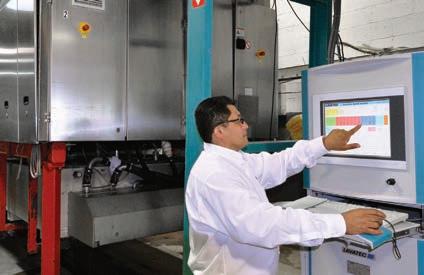
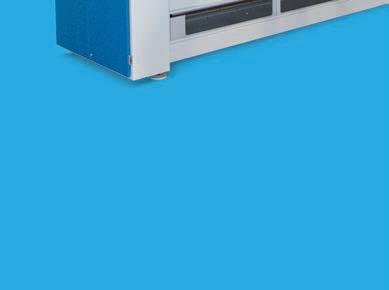

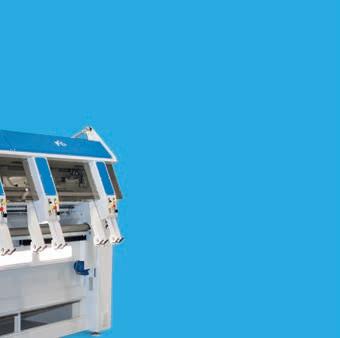
“In fact, in my 30-plus years in the industry, I must have taken five or six people with no mechanical experience and turned them into chief engineers for laundries around the country, all because Lavatec machines are so simple to understand and maintain.”
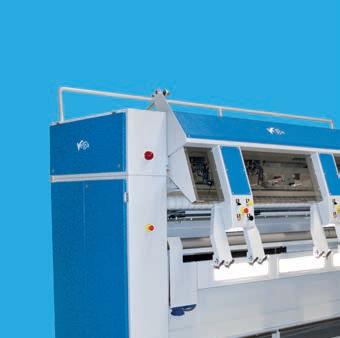
www.AmericanLaundryNews.com AMERICAN LAUNDRY NEWS | OCTOBER 2016 27
With engineer at helm, JVK Laundry Operations takes scientific approach to find right machines THE FINISH LINE STARTS HERE. 800.453.9222 www.EllisCorp.com GET CONSISTENT QUALITY WITH THE VEGA TRANSFEED SPREADER FEEDER In flatwork processing, how you start determines how you finish. The new Vega Transfeed from Ellis delivers unmatched quality and uniformity for high-volume production lines. This Spreader Feeder is available in three or four feed stations in one or two lanes configurations and, with a push of a button, it becomes a small piece feeder. Models are offered in 118”, 130”, 138” or 158” operating widths to match your equipment needs. For enhanced operator comfort and productivity, the clipping stations are height adjustable. Additional features include central lint collection, vacuum and brush assist with laydown and speed control. Give us a call or visit our website to learn more. www.VegaSystemsUSA.com ALN_Jr Page.indd 1 9/1/16 2:22 PM See PHYSICS on Page 28
and chemistry enter into equipment purchasing
Physics
Jesus Pereira, JVK’s operation manager, monitors performance data of the company’s 200-pound, 16-compartment Lavatec tunnel in Amityville, N.Y. (Photos: JVK)
PRODUCT SHOWCASE
NAPERY AND TABLE LINENS
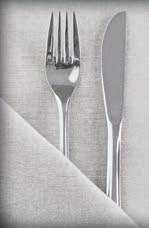
ADI AMERICAN DAWN
American Dawn’s new “Lunchkin” napkin collection includes the matching “Greenie,” according to the company.

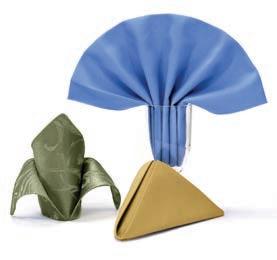
The Lunchkin collection is designed to replace paper disposables at lunch. Made from Milliken 100% spun polyester, the Lunchkin is a smaller, 12-inch-by-15-inch size, driving a much lower acquisition cost, says American Dawn.
The company adds that the “Greenie” is made from recycled polyester, and accrues a 2-cent donation to the Textile Rental Services Association (TRSA) Education Fund, as well as another environmental education fund for children—the
National Environmental Education Foundation (NEEF).
American Dawn says that for the first time in industry history, the use of linen napkins can compete with the economics of paper napkins.

The product is available in seven colors: White, Black, Caribbean Blue, Hazelnut Brown, Palm Green, Vanilla Bean, and Earth Green (Greenie). www.americandawn.com 800-821-2221
PHOENIX TEXTILE CORP.
All of Phoenix Textile’s table linen collections offered have been chosen to provide longlasting durability in institutional settings and will not fade, shrink, tear or pill, according to the company.
Made of 100% polyester, they release stains easily and process beautifully even at lower wash temperatures, giving customers the soft feel and crisp look expected from a quality partner, says the company.
And with over 150 color options, including damasks, stripes and woven tapestry styles, Phoenix Textile says it has the selection needed to
Physics
Two other things that Samuel especially likes about Lavatec are the equipment’s longevity and his ability to get original equipment parts, even for machines made more than 20 years ago.
JVK’s oldest Lavatec tunnel was built in 1996, and Samuel says Lavatec still carries all the replacement parts, from the operating computer to the software and all components to keep it running.
As proof of his preference for Lavatec, JVK’s three facilities depend on four Lavatec tunnel washers. One is a 200-pound,

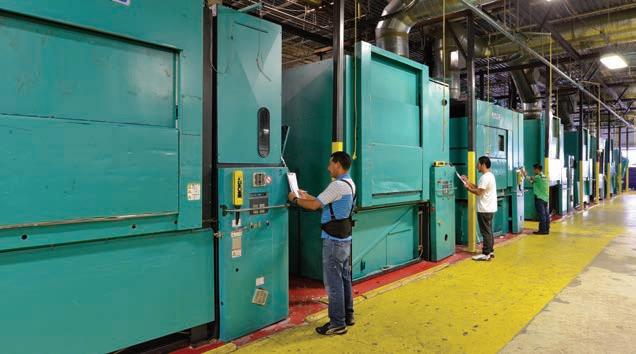
16-compartment unit.
The other three are 110-pound machines: one of them configured with 15 compartments, the other two with 12.
In addition, JVK employs 23 Lavatec dryers, five extraction presses, conveyors and a wide assortment of finishing equipment.
The output of JVK’s Lavatec systems is 700,000 pounds of laundry a week for some 22 hospitals the company serves in an area stretching from Philadelphia through New Jersey into New York and Connecticut. ALN
meet the needs of clients.
www.phoenixtextile.com 800-325-1440
VENUS GROUP
The bistro Signature Stripe napkin using Milliken fabric is one of the hottest trends in the rental or direct sales market, according

to Venus Group. With more and more restaurants discontinuing their use of tablecloths, a whole new opportunity has arisen for upgrading the tables in many restaurants.
Venus says it offers 17 different stripe colors to match most any restaurant’s décor and give them a touch of sophistication and class.
The company says the tablecloths are beautifully yarn-dyed, staying true to its original color, and can be washed with white napkins, white aprons, or with each other.

Reverse stripes and chambray options are also available with low minimums.
www.venusgroup.com 800-421-6599
CALDERON TEXTILES
Calderon Textiles has introduced Prisma™ Table Linen, the company reports. White, black and ivory tablecloths are available in 14 sizes, and napkins are available in 14 colors.

Prisma Table Linen is manufactured with a heavier fabric weight, which enhances product life, and its Color Lock dyeing technology keeps fabric bright, the
company says.

Calderon Textiles says that independent testing for tensile strength, soil release, shrinkage and colorfastness shows why Prisma is a smart choice.
The company says its extensive product offering includes towels, sheets, microfiber cloths, patient gowns, blankets, pillows, bedspreads, cubicle and shower curtains, incontinent products, and clothing protectors.
Strategically placed distribution centers in Indiana, Pennsylvania, Florida and Texas allow products to reach customers within one or two days, the company says.
www.calderontextiles.com 800-252-1986
28 OCTOBER 2016 | AMERICAN LAUNDRY NEWS www.AmericanLaundryNews.com
ALN
[Phoenix Textile Corp.]
[Venus Group]
COMPILED BY MATT POE, EDITOR
[ADI American Dawn]
[Calderon Textiles]
Continued
from Page 27
Twenty-three Lavatec 440-pound-capacity dryers are employed at the three JVK facilities.
Mayor cites years with laundry product supplier as key to success
GREENSBORO, N.C. — Eighteen years of service in the laundry industry may not be the typical path to becoming mayor of a thriving city, but for Greensboro, N.C., Mayor Nancy Vaughan, her career with Tingue’s then Talley Machinery division was critical preparation for success as a political official.
In remarks presented at the global laundry product supplier’s national sales meeting, held this summer in Greensboro, Vaughan reflected on her experience working her way up to director of operations from several other positions with the company.
She cited the Tingue family’s commitment to customer service, product quality, followthrough and ethical behavior in business and in life as key takeaways from her employment, according to the company.
“The Tingue family created a culture based on important values that translate very well to public service, like quality, integrity and delivering on promises,” says Vaughan. “I can trace all the bridges I’ve built in our community to something I learned either at the company or directly from [former CEO] Bill Tingue.”
Vaughan also noted the importance of Tingue and the former Talley Machinery as economic pillars of the community since their founding in 1902.
“Tingue invests in local talent and partners with local suppliers yet operates with a global footprint,” says Vaughan. “It’s not just a great company to work for but it’s a key part of the fabric of our economy.”
Nearly 50 Tingue executive, management, sales and support staff descended upon Greensboro, which was selected as the site of the meeting for its convenient location with direct flights from all over the country, according to Tingue Vice President Ty Acton.



“We can get our people in and out fast from Greensboro the same way we can get our parts and equipment out to our customers fast from Greensboro,” says Acton of the city known for its logistics prowess with both FedEx and UPS hubs.
Vaughan was instrumental in attracting FedEx to Greensboro while serving on the City Council and on the Piedmont Triad International Airport Authority Board, says Tingue, which is based in Peachtree City, Ga. As
hamotic driving
Greensboro, N.C., Mayor Nancy Vaughan (center), who attended Tingue’s national sales meeting, poses with Tingue CEO David Tingue (left) and Vice President Ty Acton. (Photo: Tingue)

Customer-specific control unit with membrane keypad. Connected with power control electronics via versatile interface.
Individual mechanical design – enables a customerspecific adaptation of end shield and shaft end.
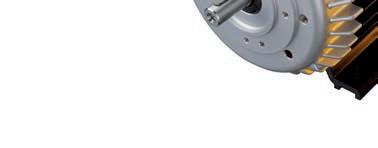
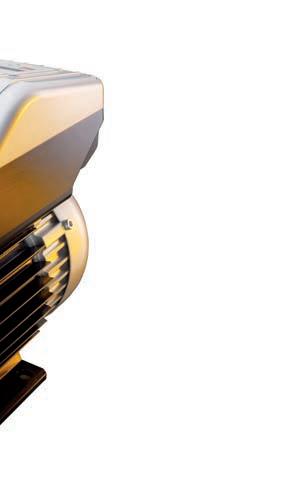
Rugged synchronous motor –compact and highly efficient. Powerful without sensor.
Low noise emission. High speed accuracy and precise run-out.

www.AmericanLaundryNews.com AMERICAN LAUNDRY NEWS | OCTOBER 2016 29
mayor, she continues to support the airport as a vital part of the city’s growth and development as a modern center of business and industry. ALN
EFFICIENT
YOUR
POWERFUL AND
FOR
PUM P A PPLICATIONS
HANNING ELEK TRO -WERKE GmbH & Co. KG Holter Straße 90, D-33813 Oerlinghausen,Germany, Tel +49 (5202)
hamotic varicon compact synchronous drive with integrated controller
707-0, www.hanning-hew.com
135x185_hew_hmo_P_07_e_4c.indd 1 09.08.16 11:16 ALN_Jr Page.indd 1 8/12/16 10:19 AM
Former Talley Machinery employee speaks at Tingue national meeting
Gurtler names Allen manager of market development

SOUTH HOLLAND, Ill. — Gurtler Industries Inc., a manufacturer of advanced detergents and specialty chemicals for the commercial laundry industry, has hired William “Dustin” Allen.
Allen
joined Gurtler in July and will be manager of market development in Georgia and portions of the Alabama area.

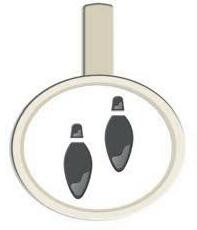
AmeriPride’s Rada retires, Schulz assumes role
MINNEAPOLIS — AmeriPride Services, a textile rental services and supply company, reports that Rojean Rada, vice president,




Track Career
secretary and general counsel, has retired. The company says it has appointed Theresa Schulz to assume the role.


“Rojean has been an essential component of our executive team for nearly 20 years and has made many valuable contributions to the organization,” says Bill Evans, president and CEO of AmeriPride. “She is an outstanding professional and legal mind and we will miss her.”
Rada joined AmeriPride in August 1996 and took over as general counsel when her predecessor retired at the end of that year. During her tenure, she supported many important projects and company transformations, including the consolidation of all subsidiaries under the AmeriPride name.
Schulz will assume Rada’s responsibilities in the company. She has been with AmeriPride for
five years as director of U.S. labor relations and human resources and has led the company’s corporate labor relations strategy in the United States, says AmeriPride.

She has counseled the company on a variety of labor and employment issues and worked cross-functionally throughout the organization with a focus on compliance, worker’s compensation, safety and employment law.
“I am very confident in Theresa’s abilities, and I know she will do well in her new position,” says Evans. “Her exceptional legal background, experience in the company and industry knowledge makes her a great successor for Rojean.”
Schulz has been practicing law for more than
20 years and has vast expertise in corporate law, says the company. Prior to AmeriPride, she served as senior corporate counsel for five years at Cosentino North America, a nationwide distributor, fabricator and installer of stone surfacing products. She also ran her own legal practice for more than 10 years and served as a litigation attorney with a law firm in San Jose, Calif., for several years.
She has a juris doctorate from the University of Minnesota Law School and a bachelor of arts degree from Indiana University.
MODRoto names Rodriguez national sales manager

MADISON, Ind. — Laundry cart manufacturer MODRoto has named Dan Rodriguez national sales manager, the company reports.
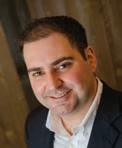
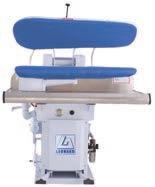
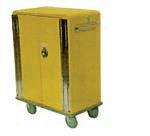

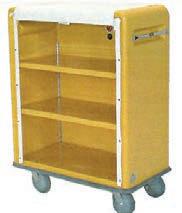
The company says that Rodriguez, a noted brand strategist and former Tingue sales representative, is responsible for driving the company’s sales strat-
egy, including growing the brand in new and existing markets, providing leadership and direction for his team of North American field sales representatives and customer service staff, and offering support for the company’s global network of distributors.
Bringing 15 years of experience in sales, marketing and management to the plastics rotomolder, Rodriguez earned a reputation for putting the customer first and delivering bottom-line results, according to J.R. Ryan, president and COO of MODRoto, a Tingue family company.
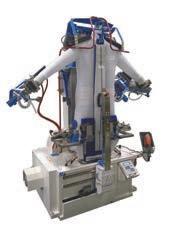
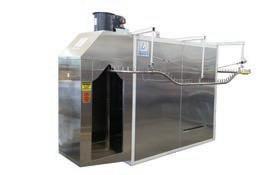
“Dan has hands-on knowledge of laundry operations and an insider’s view of the changes affecting marketing communications today,” says Ryan, “but it’s his proven commitment to serving our customers and helping the people around him succeed that makes me especially proud to
 Rada
Rada
30 OCTO BER 2016 | AMERICAN LAUNDRY NEWS www.AmericanLaundryNews.com Store and Move Linen Securely Manufactured from fire-retardant fibeglass Adjustable shelves Recessed push handles Three sizes available Heavy non-marking bumper protects cart and its surroundings Model L-55 M c C LURE INDUSTRIES, INC. 800-752-2821 • www.mcclureindustries.com email: kim@mcclureindustries.com Visit our website for other models and avaliable options. We sell direct Easy roller bearing casters Foot operated directional lock 8” gray, non-marking caster works well on all surfaces Stainless steel security lock Doors supported by heavy duty stainless steel piano hinge Opens completely for easy access Model L-55DL Optional Door Casters 1016aln_McClure_Jr_half.indd 1 9/14/16 2:56 PM Building more than the best equipment... ...building relationships that last. PO Box 501 Denver, NC 28037 ph: 704.483.9316 / fax: 704.483.4538 sales@leonardautomatics.com http://leonardautomatics.com Pressing Equipment Tunnel Finishers Cart Washers ALN_Jr_half.indd 1 9/2/16 11:52 AM Allen
Schulz
Rodriguez
welcome him to this position.”
Rodriguez represents the company’s iconic Poly-TruxTR brand laundry carts, recycling carts and Ship Shape material-handling containers and accessories.


Rodriguez is a graduate of Boston University with a bachelor of science degree in communication. He resides in Minneapolis with his wife and two children.
Lavatec hires Slatcher as regional sales manager

BEACON FALLS, Conn. — Industry veteran Jim Slatcher has joined Lavatec Laundry Technology as Western regional sales manager, according to the company.


A second-generation laundry industry manager with over 30 years of operations experience, Slatcher will be responsible for developing and expanding Lavatec’s


presence in 10 states, including Alaska and Hawaii, the company says.
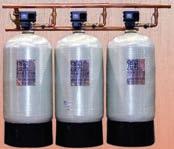
For the last 11 years, Slatcher has managed his own consulting company where he assisted clients in the design, management and build-out phases of new facilities, in addition to financial and operational optimization, according to Lavatec. He also managed an on-premises laundry in Mesquite, Nev., for the last four years.
Slatcher’s career has included stints with Textek, Sodexo, Crothall and Tartan in every region of the United States. The company says he has a distinct familiarity with Lavatec equipment.
“When I first started in the laundry industry, I worked for Western Linen Services (Service Control Corp.), which was a five tunnel, all-Lavatec plant. Throughout my career, various plants I managed had Lavatec equipment, as well as some of my clients,” says Slatcher. “I accepted this position to help customers effectively improve their operations through the purchase of what I consider the most reliable equipment manufactured in the world.”

“I’ve known Jim for many years, including the time he spent with Sodexo and Tartan in South Florida and when he was at Textek in Georgia,” says Keith Ware, Lavatec’s vice president of sales. “His father was involved in the laundry business, so Jim was well-prepared right from the beginning. His addition really strengthens our team, and I’m looking forward to working with him.”
New global service technician, project manager at Leonard













DENVER, N.C. — Leonard Automatics has named Marc Helton as a global service technician and Mark Farnsworth as a project manager, the company reports.
For almost 15 years, Helton has been on the team at Leonard, according to the company. In 2001, Helton began using his technical experience to install finishing equipment at Leonard.



Over the years, the company says Helton learned the intricate details of how to build the whole machine inside and out. When Leonard integrated a state-of-

the art laser cutting and bending system, Helton mastered its operation. When Leonard introduced a multi-lane draping stacker, Helton learned how to service and install it.
He also stepped in as foreman of Leonard’s manufacturing operation for several years, providing him with invaluable knowledge of the process of building and testing all of Leonard’s finishing equipment, the company says.
The position of global service technician in the service department is similar to his first role at Leonard, but in a whole new evolution of the business and state-of-the art facility, according to the company.
In addition to the breadth of knowledge that Helton brings to the company, he uses his experience for machine installations and customer training in the United States and abroad, says Leonard.
Prior to Leonard, Helton
worked as a weapons technician in the Navy, building and testing Tomahawk cruise missiles. He is married with two children.



Farnsworth is in charge of managing and filling customer orders, according to Leonard.
Farnsworth spent 20 years as chief engineer with Seneca Foods running unlimited horsepower boilers. Prior to that, he was in the Navy working as a gas turbine technician.
The company says that since Farnsworth has been on the receiving end of the types of products and services that Leonard provides, he understands the frustrations that customers can have. His goal is to alleviate those frustrations to ensure that customers receive exactly what they ask for, have their orders filled on time and are completely satisfied.

Farnsworth relocated to North Carolina and is married

www.AmericanLaundryNews.com AMERICAN LAUNDRY NEWS | OCTOBER 2016 31
PEAKSOFTWATER SOFTENER HARD WATER SOLUTIONS Water quality is no problem when you have Hamilton! • The life expectancy of your water heater can be extended by up to 15% • Increases fabric life by removing residual hardness minerals • Scale build up causes heat retention and reduces heat conductivity; softened water does not cause scaling • Fewer chemicals means less rinsing and less mechanical action • Savings of up to 25% in water heating costs OddWat Packag e PeaksoftW erSofte n e r IndirectCo panio n ALN_Jr_half.indd 1 9/14/16 3:03 PM Connect With Us PARISER INDUSTRIES, INC. www.pariserchem.com 91 Michigan Ave. info@pariserchem.com Paterson, NJ 07503 800-370-SOAP (7627) USA LAUNDRY CHEMICAL SOLUTIONS FOR YOUR EVOLVING INDUSTRY For over 40 years, Pariser Industries has been dedicated to providing our customers the best Quality Laundry Products, Value and Consistent Performance, Wash after Wash. Our Service and Expertise Spans the US, Canada and Caribbean in these industries: Hospitality • Resort/Cruise Ships • Hotels • Party Rental Companies Healthcare • Nursing Homes, Assisted Living • Surgical Centers • Hospital Scrubs and Clinic Linens • Veterinary Sports Athletic Garments • Athletic Team Uniforms • Health Club Towels Pariser has the products and reliable service to help you achieve clean, hygienic linens in an efficient and economical manner. For a Free Customized Estimate call 800-370-SOAP (7627) ALN_Jr_half.indd 1 11/9/15 9:37 AM
Farnsworth
Slatcher
See CAREER on Page 32
Helton
with six children.
Pellerin Milnor adds project, regional sales managers

KENNER, La. — Pellerin Milnor Corp. has added Jacob Fleming and Bradley Jouty to the Milnor team, the company reports. In addition, Scott Voldbaek has been hired as a regional sales manager.


Fleming, a 2016 graduate of the University of LouisianaLafayette, is a newly hired applications engineering project manager, according to the company.


He earned a bachelor’s degree in industrial technology and has a background as an electrician.

“Jacob plans to be an addition that will help in customer satisfaction and efficient production design,” says Mike Diedling, application engineering manager.
Jouty is a 2016 mechanical engineering
graduate of the University of Louisiana-Lafayette. He will be working for applications engineering at Milnor as a project manager and brings four years of 3-D modeling experience to the position.
“Bradley looks forward to growing as an engineer and enhancing our presentation offerings with 3-D renderings,” says Diedling.
Voldbaek comes to Milnor with more than 20 years of sales and marketing experience within the laundry industry, the company says. He has worked closely with dealers and end-users alike.
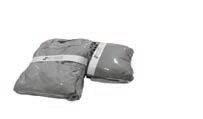
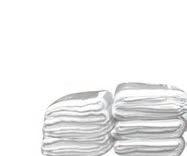

Based in Portland, Ore., Voldbaek will be responsible for supporting Milnor’s extensive dealer network throughout the Western and Midwestern United States and Canada, Pellerin Milnor says.
CG West welcomes Munoz, Valdovinos to its staff


SANTA FE SPRINGS, Calif. — Distributor Continental Girbau West recently hired Efrain Munoz as technical support and service manager and Hilario Valdovinos as service technician, the company reports.
“We are thrilled to have Efrain and Hilario as part of the CG West team,” says Tod Sorensen, CG West vice president. “Efrain
has been affiliated with us for a number of years, and we rely on him greatly to provide expert technical help to our customers and distributors in the field. Hilario will report directly to Efrain and provide additional field support.”

Munoz, of Pinon Hills, Calif., will provide expert technical field support relative to product installations and service for CG West. He will also assist with customer training and product education.


Munoz was born in Costa Rica, where he attended Colegio Vocacional Monsenor Snabria on electromagnetism and residential and industrial electricity. He served the Instituto Costarricense de Electricidad for 10 years, and during that time, was among the first 16 technicians in the country to specialize in digital telecommunication installations, according to the company.
He holds more than 3,000 hours of trade training in Panama, Mexico, Costa Rica, France, Sweden and Brazil as part of the modernization of the Central American infrastructure. Since 2013, he’s served CG West in one capacity or another, handling and inspecting vended laundry installations and developing installation training programs for vended laundry owners and technicians.
Valdovinos, of Los Angeles, holds several years of experience







repairing and installing commercial laundry equipment, the company says. He will perform equipment installations and service vended and on-premises laundry equipment. He will also help customers and staff with technical assistance, product information and installation estimates.
PANAMA CITY, Fla. — JENSEN USA Inc. has hired Alex Duke as regional vice president of sales, Mark Schuler and André Chartier as sales systems designers, and Mathew Messer and Doug McElwain as project managers, the company reports.

Duke is responsible for the Western region, and the company says he brings more than 15 years of industry sales experience to JENSEN, most recently as West Coast vice president of textiles with Medline. Duke is a wellrespected veteran of the industry with relationships that resonate his level of success, JENSEN says.
Schuler has been in the design/




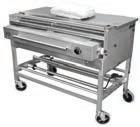

build/installation industry for more than 25 years, according to JENSEN. His experience portfolio includes the design of semiconductor equipment, modular high-speed robotic pick-andplace equipment, optical and laser inspection systems for the defense and aerospace industries, and both portable and permanent dry sorbent pollution mitigation systems for coal-burning power plants. The company says Chartier is a 30-year engineering veteran. He comes to JENSEN after spending 25 years in the oil and gas industry where he held positions ranging from CAD designer to engineering manager. Most recently, he developed engineering training materials. The company says Chartier also has experience in the mobile power stations industry.
Messer comes to JENSEN with project management experience, working in the aerospace and petroleum industries, according to the com-



JENSEN makes sales, project mgmt. department hires
Fleming Jouty
Munoz
Duke
Valdovinos
32 OCTO BER 2016 | AMERICAN LAUNDRY NEWS www.AmericanLaundryNews.com ALN_3rd Page.indd 1 7/7/16 10:23 AM e ve o you covered! contact@davispackaging.net ▪ www.davispackaging.net 800-622- 3015 or 561- 290-0412 Parts Mini Bundlers Laundry Wrap Dual Roll Consoles Minimize Cost, Loss, and Contamination Simplify Content Identification and Delivery Enhance Your Delivery Presentation Laundry Wrapping Equipment & Supplies ALN_3rd Page.indd 1 8/1/16 9:30 AM Voldbaek
Schuler
Messer
Continued from Page 31 Career
Chartier
pany. He holds degrees from Georgia Institute of Technology and the University of Alabama in Huntsville. The company says he has designed programs for NASA, helicopter components for Sikorsky Aircraft, designed chemical plants/oil refineries, and designed and helped drill oil wells for BP and Halliburton in the Gulf of Mexico.
JENSEN says McElwain brings more than 20 years of project management, engineering, and manufacturing experience in multiple capital equipment industries to the company. He received a bachelor of science in electrical engineering from the University of Texas. His most recent role was operations and engineering manager for DeTect Inc., manufacturer of radar systems for aviation, energy, environmental, and security markets.
The company says a key part of McElwain’s role is leading the project management team in support of U.S. and Canadian
clients. He recently obtained his PMP certification and is a member of the board of directors for the PMI Emerald Coast-Panama City Chapter.
Wilson joins Braun’s field sales organization
SYRACUSE, N.Y. — G.A. Braun Inc. has hired Steve Wilson as its new regional sales manager, the company reports.



“Steve’s exceptional knowledge and experience in plant operations will provide our clients the best in consultative services and laundry equipment solutions,” says Jim Corrigan, Braun’s West Coast regional VP of sales.
The company says Wilson’s area of coverage will be Braun’s Mid-Southwest U.S. territory, spanning the states of Arkansas, Colorado, Kansas, Louisiana, Missouri, New Mexico, Oklahoma and Texas.

Wilson studied engineering at the University of Michigan and California State UniversityFullerton. Braun says he has more than 23 years of commercial and industrial laundry experience.





Energenics Corp. promotes veteran to VP/general manager
NAPLES, Fla. — Timothy A. Sulecki has been promoted to vice president and general manager of Energenics Corp., the company reports.
Sulecki has worked for Energenics for more than 10 years in various positions, culminating as technical design manager.

The company says that Sulecki will supervise all employees while continuing to report to John Hutterly, Energenics’ CEO.
Bryant Dunivan, VP sales and marketing, and Mary Ann Rule, controller, both part owners of Energenics, will continue

Crown Linen Service reaches fifth generation of ownership

ST. LOUIS — In 1891, nine years before the St. Louis Cardinals were known as the Cardinals, a small shirt-starching business in Mexico, Mo., opened its doors.
Now, five generations later and still family-owned, Crown Linen Service turns 125 years old, the company says. It is locally operated in Columbia, Ill., and Mexico, Mo.
“It’s our people that make us who we are today,” says President Tim Williams, whose great-grandmother steered the company through the Great Depression. “The average tenure of our office staff at our Mexico facility is 25 years. We are committed to our employees and, as employees, we are all committed to our customers.”
No longer starching shirts, Crown Linen says it is now a complete linen rental service, providing the restaurant and hospitality categories with a wide array of necessities, including tablecloths, napkins, chef uniforms, kitchen linens, towels and more.
Crown Linen says it continues to move forward relying on the principles it was founded on: high-quality service, commitment to employees and placing an emphasis on satisfying customers’ diverse linen needs.

“We take a vital part of our customers’ operations and make it turn-key and worry-free,” says Williams. “Our goal is to help our customers make the best possible impression with their customers.” ALN
in their current roles, according to the company.


Sulecki is a native of Naples and a graduate of Florida Gulf Coast University with a degree
in management. In addition, he has attended advanced management courses at Northwestern University’s Kellogg School of Management. ALN



www.AmericanLaundryNews.com AMERICAN LAUNDRY NEWS | OCTOBER 2016 33
ALN_Jr_half.indd 1 9/1/16 11:25 AM 4 REASONS TO CHOOSE PARKER BOILER BETTER ENGINEERED Tel: (323) 727-9800 Fax: (323) 722-2848 5930 Bandini Blvd, Los Angeles CA 90040 Low NOx Models Are Certified SCAQMD Rule 1146.2 Never a Compromise for Quality or Safety sales@parkerboiler.com
1BetterEngineered 2BetterPackaged Since 1919 Parker boilers have been engineered for more efficient operation (whether gas, oil, or combination gas/oil fired) for delivery of hot, dry steam in less than 10 minutes. And Parker boilers have a longer service life for a greater return on your investment. All Parker boilers are delivered complete, ready to connect to utilities. What’s more, every boiler is test fired before it leaves the factory so you can count on getting up and running as soon as possible. Kompact mounted return systems are available on 3 to 25 hp boilers to save on installation costs. 3BetterDesigned 4Better Value Parker boilers are designed for ease of routine maintenance, annual inspections, and on site repairs, so there is less down time, more reliability. Parker boilers also have extra heavy, insulated, double-wall steel cabinet construction (Stainless steel cabinet lids and/or sides available). All of Parker’s superior quality boilers are available at competitive prices and have been distributed through our regional representatives for over 60 years. A S M E S or H Steam Boilers From 1.5-150HP Steam Boiler Accessories Feed Systems, Blow Off Tanks, Water Softeners and Chemical Feeders Indirect Water Heaters From 288-2878 Gallons per hour 100° Rise Thermal Liquid Heaters From 126,000 to 6,250,000 BTU 10x13.5 add-oct15.indd 1 ALN_Jr_half.indd 1 9/14/16 10:08 AM
www.parkerboiler.com
McElwain
Wilson
Sulecki
Northwest Health Care Linen reaches safety milestone
BELLINGHAM, Wash. — Northwest Health Care Linen (NWHCL), a medical textiles launderer based here, reports that on Aug. 3, it celebrated four years of operations without a lost-time injury.
The company says the accomplishment is the result of NWHCL’s strong focus on employee safety.
“Safety is no accident and we strive each day to make it our No. 1 goal,” says James Hall, CEO at NWHCL.
The company says that each day, its focus is on safety, quality and quantity—in that order. As a team, the managers and employees strive to send everyone home at the end of their shift in the same or better shape than when they arrived, NWHCL says.
NWHCL hosted a celebration barbecue at its facility for all the employees in mid-August to celebrate the safety accomplishment.
Dignity Health Central Coast expands partnership with Applied Silver

CENTRAL COAST, Calif. — Dignity Health and Applied Silver, the maker of SilvaClean®, have expanded their partnership, the companies report. Three Central Coast healthcare facilities will utilize the proprietary textile protection system to enhance the hospital stay experience.
the level of cleanliness that SilvaClean delivers to existing textile inventories,” says Sean Morham, CEO of Applied Silver. “We are proud to offer our Central Coast communities this Cal Poly-inspired breakthrough technology that is eco-friendly and provides an exceptional bedside experience.”
Companies team on water recycling system for commercial laundries
JOHNSTOWN, Pa., and HOUSTON — Concurrent Technologies Corp. (CTC) and Water Energy Technologies have entered into a partnership for collaboration on a firstof-its-kind green laundry system to benefit large commercial laundry operations, the companies report.
Engineers and scientists have seamlessly integrated two proven technologies into a treatment system that significantly reduces water usage by safely and reliably processing and recycling 90% of greywater generated by laundry operations, according to the companies.
This energy-efficient, scalable and fully automated solution will save water, energy and time, say CTC and Water Energy Technologies. In addition, it will eliminate chemicals and reduce maintenance.
Water Energy’s proprietary ozone treatment technology was originally developed for the National Aeronautics and Space Administration (NASA). Ozone works 3,000 times faster at destroying bacteria than chlorine bleach, according to the company, and commercial laundry facilities report their sheets and linens feel like new when washed in ozonated water.
CTC’s water recycling system was originally developed for the Department of Defense, according to the company. The system relies upon a three-stage, temperature-tolerant filtration sequence. Its uniqueness comes from incorporating separation media not traditionally used in water filtration. In addition, customized control logic optimizes backwash recirculation and increases the overall processing rate. CTC says it was awarded a prestigious Edison Award for this technology.
companies to offer a world-class water system that will help our clients save energy and decrease costs.”
Bob Beddingfield, president of Water Energy Technologies, says, “Water Energy Technologies has worked for more than three decades to bring innovative ideas, advanced technology and professional consulting services to the commercial laundry industry.
“We are proud to have joined forces with Concurrent Technologies Corp. to provide a superior finished product and create a ‘Green Solutions Team’ focused on providing effective and affordable solutions to save on water, energy and chemical costs.”
OMNI Solutions, TwinMed enter into installation agreement
MADISON, Wis. — OMNI Solutions has been awarded an 8,000 Lux Hydroxyl Laundry System installation agreement with TwinMed LLC, a full-line medical supplies distributor, the company reports.
OMNI Solutions says it provides innovative, earthfriendly on-premises laundry and housekeeping cleaning solutions, primarily to customers in the healthcare and hospitality marketplace.
OMNI Solutions’ line of laundry detergents, softeners and stain removers are injected into standard commercial washing units through their patent-pending LUX Hydroxyl System to “supercharge” the washing process, according to the company
The supplier agreement with TwinMed spans five years with the goal of installing 8,000 LUX Hydroxyl Systems. TwinMed will also carry OMNI Solutions’ housekeeping product lines.
“OMNI Solutions’ innovative design reduces energy and water consumption, empowering healthcare operators to further their green initiatives,” says Andrew Rupnow, founder of OMNI Solutions. “TwinMed is an outstanding resource for healthcare facility operators, and we are very pleased to be included in their product offerings.”
SilvaClean, a patented water-based ionic silver treatment, will provide protection to laundered linens for patients and healthcare workers at Arroyo Grande Community Hospital, French Hospital Medical Center and Marian Regional Medical Center, with plans to further expand the service to other Dignity facilities, according to the companies.
“This partnership is a testament of Dignity Health Central Coast’s commitment to the highest level of safe, quality healthcare services that our employees and physicians provide each and every day,” says Charles J. Cova, senior vice president of operations, Dignity Health. “We have made and continue to make a significant commitment to education and training, and we continue to invest in state-of-the-art technologies that enable our staff and physicians to provide the highest quality of care available.”
SilvaClean works on a wide range of fabric items by imparting lasting antimicrobial properties to the items each time they are laundered, protecting them in transport, storage and use from bacteria and fungi, according to Applied Silver. These fabric items include multiple key patient and healthcare worker touch points such as patient bedding, gowns, bath towels, worker scrubs and privacy curtains.
“SilvaClean is a new standard for enhancing environmental cleanliness through textiles. The technology is capable of reducing 99.9% of odor- and stain-causing bacteria, helping Dignity Health meet ever-stricter administrative targets and the quality expectations of the communities they serve,” says Dr. J. Trees Ritter, a medical director of the infection control programs for five California Central Coast hospitals and chairman of the Clinical Affairs Committee of the Infectious Diseases Society of America.
“No previous textile management solution provides
“Concurrent Technologies Corporation has a long history of partnering with other innovative technology providers, and we’re pleased to be working closely with Water Energy on this important project,” says Jeff Grabarek, CTC senior director, business development. “We look forward to combining the skills and know-how of our two great
Calendar
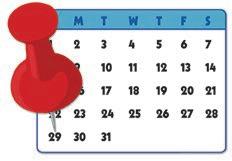
October
2-4
Textile Rental Services Association
European Laundry Tour Info: 703-519-0029
17-21 Association for Linen Management Laundry and Linen College: Production and Operations Richmond, Ky.
Info: 859-624-0177
20 Association for Linen Management Webinar: Converting from Disposable to Reusable Textiles Richmond, Ky. Info: 859-624-0177
26-27 Textile Rental Services Association Production Summit & Plant Tours
“More businesses are focusing on integrating environmental sustainability practices into their operations,” says Meyer Greenbaum, executive vice president of business development for TwinMed. “We are really excited to be able to offer our customers the Lux Hydroxyl Laundry System to help further corporate responsibility and green initiatives.” ALN
New Orleans, La.
Info: 703-519-0029
November
17 Association for Linen Management Webinar: Benefits of Using a Linen Management System Richmond, Ky. Info: 859-624-0177
30- Textile Rental Services Association
Dec. 1 TRSA Healthcare Conference Nashville, Tenn. Info: 703-519-0029
December
2 Textile Rental Services Association
TRSA CEP/Executive Roundtable-Healthcare
Nashville, Tenn. Info: 703-519-0029
January
26 Association for Linen Management Webinar: Ask the Experts: Part 1 Productivity Richmond, Ky. Info: 859-624-0177
February
23 Association for Linen Management Webinar: Managing from Afar Richmond, Ky. Info: 859-624-0177
34 OCTOBER 2016 | AMERICAN LAUNDRY NEWS www.AmericanLaundryNews.com
Dignity Health is going to use SilvaClean at its Arroyo Grande Community Hospital, plus the French Hospital Medical Center and Marian Regional Medical Center in California. (Photo: Dignity Health)
ALN











www.AmericanLaundryNews.com AMERICAN LAUNDRY NEWS | OCTOBER 2016 35 Classified Advertising facebook/ americanlaundrynews Like our Facebook page Share our content Comment: Tell us what’s on your mind LIKE 0616aln_House Facebook jr_half.indd 1 5/5/16 5:19 PM AmericanLaundryNews.com More than unique visitors annually! 63,0000 Company Page Company Page INDEX OF ADVERTISERS A.L. Wilson Chemical Co. 9 ADI American Dawn 5 ADC 13 Brightwell Dispensers 21 Carilon Clinic 36 Consolidated Laundry Machinery 17 Davis Packaging 32 Direct Machinery Sales Corp. 36 Ecolab 18 EDRO Corp. 12 Ellis Corp. 27 G.A. Braun 23 Girbau Industrial 7 Hamilton Engineering 31 Hanning Electro-Werke 29 The Griffin Group, Inc. 36 J.P. Equipment 35 Kannegiesser USA 19 Kemco Systems 32 Leonard Automatics 30 LaundryCareers.com 36 Lavatec Laundry Technology 40 McClure Industries 30 Monarch Brands 10, 11 Pariser Industries 31 Parker Boiler 33 Pellerin Milnor 3 PSP Industrial 35 Royal Basket Trucks 8 SonicAire 33 Stanco Industries 35 TQ Industries 23 UniMac 15 U.N.X. Inc. 25, 36 EQUIPMENT FOR SALE We worry about it so you don’t have to Project Management, Consulting, Facility Planning, Rigging, Turn Key Installations, Equipment Appraisals & Reports. O ering turn key Laundry Solutions nationwide. IN STOCK EQUIPMENT FOR SALE: Qty Jensen SEP72MP Press 1 Chicago Edge Maxx Feeders 2 Chicago King Edge & Kannegiesser Feeders 3 Chicago Skyline Sheet Folders 6 Lavatec TT745GU Gas Dryers 8 Braun Towel Folders 9 Challenge 400 LB Gas Tunnel Dryers 6 Rebuilt Milnor 170 LB W/X 1 Jensen EXPG-12 Self Contained Gas Ironer 1 Chicago Century 2 Roll x 42 Steam Ironer 1 www.pspindustrial.com Main: 1.800.517.1432 / 305.517.1421 Please visit our website for our complete inventory www.ineedjpequipment.com 800/925-3236 “Expect Excellence” DISTRIBUTOR OFFERINGS DISTRIBUTOR OFFERINGS • 50 HP Atlas Copco Rotary Screw Air Compressor • 1997 Chicago Tristar 24”x120 Gas Ironer with built in folder/ crossfolder • 1993 Chicago Imperial 48”x120” Gas Ironer • 200 lb Braun OP, non-tilting, single motor inverter drive • 1999 Milnor 135 lb Rigid Mount Washers (bearings recently replaced) • 2006 Braun 200 lb TSL • 1997 Braun 200 lb TSL • 1998 900 lb Ellis Washer/Extractor • (2) 1995 Milnor 550 lb Washer/Extractors (make offers) • Challenge Dryer 400 lb gas dryer • 1993 Braun 440 Gas Dryer • 2009 Jensen Logic Feeder • 2000 Jensen Logic Feeder • 1998 Chicago Air XL • 1997 Braun RTF Meterwide Triple Sort folder • 2005 Jensen Classic “s” Folder, Single lane with dual stackers • 2008 Chicago Pik Quik • 1998 Milnor 110 lb Softmount washer • 1995 Milnor 9 mod 90 lb G2 CBW with 2 stage press, shuttle, and 4 dryers. Great System • 1997 Passat Tunnel, UT5012 • 2002 Kann Press EP865-35 Stanco Industries, Inc. Serving The Textile Trades Since 1970 800-932-3769 k for Mike or Deb KEEPING IT GREEN SINCE 1970 FOR SALE: • Lavatec 400# Gas dryers 1-2002 Washex Floatair135# W/E 1-Jensen Jenroll EXG8 Ironer and Folder WE NEED: • Braun/Brim Open Pockets • Hypro Ironers • Towel Folders • Direct Contact Water Heaters • Boilers • CBW ALL TYPES OF EQUIPMENT WANTED Stanco Industries, Inc. 800-932-3769 Ask for Mike or Deb or e-mail: stanco2626@aol.com www.StanCoInd.com EQUIPMENT FOR SALE AMKO AMERICA, INC. Remanufactured Finishing Equipment Delta Ironers, Omega Folders & Towel Folders PARTS, IRONER SUPPLIES & NEW EQUIPMENT ALSO AVAILABLE “NEW” SELF CONTAINED IRONERS Contact: (561) 863-9696 AmkoAmerica@gmail.com INTERNATIONAL EQUIPMENT GROUP Dealers in all Types, Makes & Sizes of pre-owned Laundry Processing Equipment & Supplies * buy * sell * liquidate * locate * * rigg & transport * email: loustanley69@hotmail.com Phone: 260 409-2547 C ONTACT : C LASSIFIEDS @ AMERICANTRADEMAGAZINES . COM
Senking
Colmac
Braun
Milnor
American
Chicago
Challenge
Braun
Cleaver

Jensen
White

Braun
Kemco
Laundry Services Director


Carilion Clinic is seeking a Laundry Services Director who will be responsible for business development, customer satisfaction and retention, as well as production, quality assurance, budgeting, maintenance, and office and distribution functions. The Laundry Services Director also promotes a positive, rewarding and service-oriented work environment in support of high quality patient-centered care, exceedingly competent and engaged staff, and the achievement of fiscal, scorecard and process improvement goals and objectives.

• Bachelor’s degree in business administration, production management or related field required.
• Ten (10) years managerial or supervisory experience in a commercial or institutional laundry facility, with a strong track record of success in the oversight of sales growth, vendors, purchasing programs, multiple cost centers and operational and financial performance required.

• Certification as Certified Laundry Manager required. Registration as Registered Laundry Linen Director & membership in National Association of Institutional Linen Management desired.
Based in Roanoke, Va., Carilion Clinic includes multi-specialty physician practices, seven not-for-profit hospitals and the Virginia Tech Carilion School of Medicine and Research Institute in partnership with Virginia Tech.



Our facilities include a Level 1 Trauma Center, Level 3 Trauma Center and outpatient clinics that are located in metropolitan centers, college towns, and hometown communities in western Virginia. This area is rich in history and natural beauty, and offers an abundance of recreational opportunities along the Blue Ridge Parkway and area lakes. To learn more about the area, go to www.visitroanokeva.com. Relocation assistance available, competitive pay and benefits package. Apply online at www. carilionclinic.org or contact Kathy Harrison at KCHarrison@carilionclinic.org. Equal

36 OCTOBER 2016 | AMERICAN LAUNDRY NEWS www.AmericanLaundryNews.com Classified Advertising POSITIONS AVAILABLE POSITIONS AVAILABLE For more classifieds visit: AMERICANLAUNDRYNEWS .com www. Call Craig Lloyd toll free at 877.295.5693 between 9 a.m. – 9 p.m. EST. Please visit www.laundrycareers.com to review current industrial/institutional laundry management openings. ADVANCE YOUR CAREER The Griffin Group, Inc. “Recruitment Specialist” Need to FILL a position? Call Deana Griffin 888-235-2365 www.thegriffingroup.cc deana@thegriffingroup.cc ® PARTS FOR SALE EQUIPMENT FOR SALE COMPLETE PLANT OF LAUNDRY EQUIPMENT FOR IMMEDIATE SALE For fastest service, call Ron Hirsch direct at 516-938-4300 Oceanside Laundry Facility closed! Direct Machinery is the exclusive dealer for all equipment in this sale. With the plant now closed, everything must go! HERE’S SOME OF THE SPECTACULAR EQUIPMENT: PLUS CONVEYORS, CARTS, LIFTS, SCALES AND MUCH MORE! CALL TODAY! CONTACT: CLASSIFIEDS@ AMERICANTRADEMAGAZINES.COM U.N.X. INCORPORATED“ ” grow & expand U.N.X.! U.N.X. INCORPORATED WASHEX PARTS Hard-to-find Washex parts, on-site rebuilding, tech support. LAUNDRY PARTS CENTER 800-352-4492 Fax: 305-827-3991 PARTS, PARTS, PARTS Huge stock of parts for most laundry equipment & boilers. Also traps, valves and lubricants. Overnight delivery. Steiner-Atlantic, 800-333-8883 Fax: 305-751-8390 parts@steineratlantic.com www.steineratlantic.com
CBW 20 Mod 110lb Tunnel (3)
Steam Tunnel System 2100-2
Folder/Crossfolder with Stacker (1)
72072 500lb Gas Pass-Through System Dryers (2)
Hypro 8 Roll Ironers (3)
Edge Spreader Feeders (3)
Pace Setter Gas Dryers (1)
Rear Discharge Small Piece Folders (10)
Brooks 400HP Dual Fuel Boilers (2)
250lb L Tron (1)
Conveyors
600lb Top Side Loader
Direct Contact 3 Million BTU with Heat Recovery and Storage
Opportunity Employer
POSITIONS AVAILABLE Get the info you need online... www.AmericanLaundryNews.com
Minorities/Females/Protected Veterans/Individuals with Disabilities/Sexual Orientation/ Gender Identity.
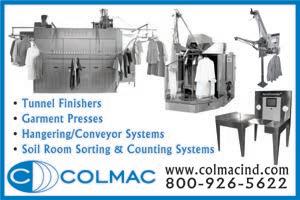
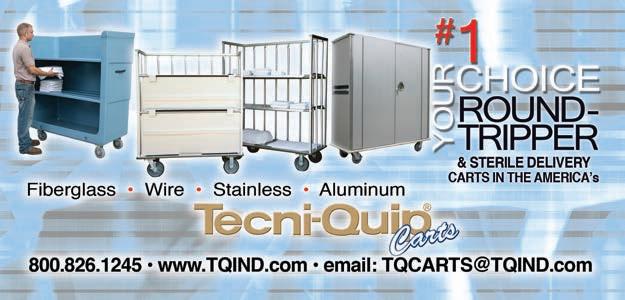
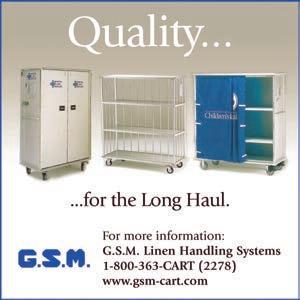

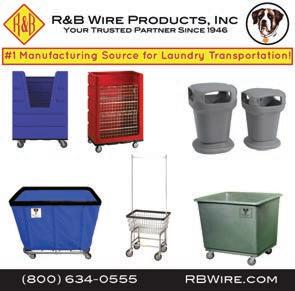




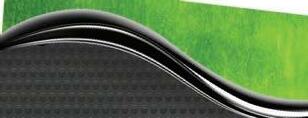

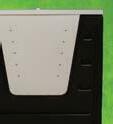










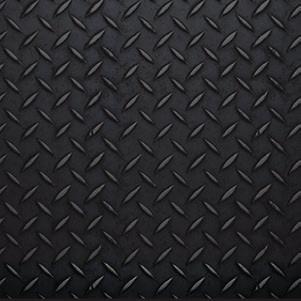





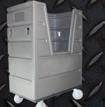



www.AmericanLaundryNews.com AMERICAN LAUNDRY NEWS | OCTOBER 2016 37 Source Directory A convenient guide to sources of products and services APPAREL FINISHING CARTS, TRUCKS & BASKETS Source Directory listings in American Laundry News are sold on an annual basis at the following rates: All Major Credit Cards Accepted 2016 Listings Regular Boldface All Caps All Caps, Boldface Four Line Listing per Year $885 $1,110 $1,110 $1,175 Display and additional line rates available upon request CARTS, TRUCKS & BASKETS CARTS, TRUCKS & BASKETS AmericanLaundryNews.com More than unique visitors monthly! 5,250 CARTS, TRUCKS & BASKETS Round-Tripper_6.25x3:Layout 1 6/17/14 12:04 PM Page 1 M.I.T. POLY-CART 211 CENTRAL PARK WEST, NEW YORK, NY 10024 800-234-7659, FAX: 212-721-9022 WWW.MITPOLYCART.COM Diversified Plastics, Inc. 1309 Highway 917 West, Latta, SC 29565 800-768-7636, www.dpirotocarts.com E-mail: sales@dpirotocarts.com Fax: 843-752-7798 100% RECYCLED 800.304.4600 www.FIBERTECHINC.net We Create Environmentally Responsible Solutions • SAME DURABILITY • SAME CAPACITY • SAME PERFORMANCE BETTER PRICE M c C LURE INDUSTRIES, INC. 800-752-2821 • www.mcclureindustries.com email: kim@mcclureindustries.com Sani-Trux is the only molded cart to pass rigorous independent laboratory testing for NFPA fire codes Made of durable fiberglass making the cart life at least twice that of a poly cart Easy to maneuver even in tight spaces Built with quality components to last years longer than other carts Visit our website for other models and avaliable options. We sell direct to all parties! DOBERMAN TUFF LAUNDRY CARTS www.dobermantuff.com 706-376-4793 ♦ RUGGED ♦ DURABLE ♦ QUALITY FINISHES TUFF STUFF, NOT TUFF PRICES
www.gardnermachinery.com
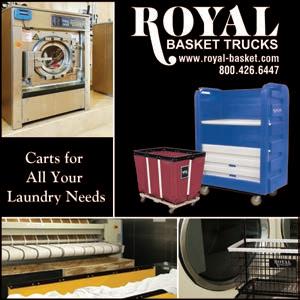





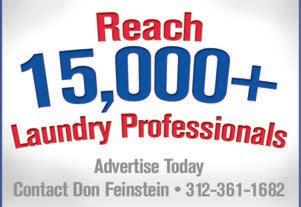




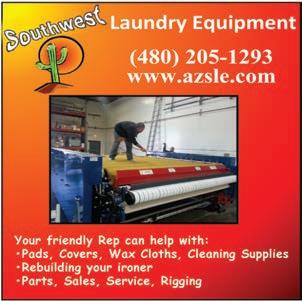

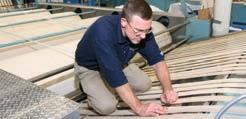
38 OCTOBER 2016 | AMERICAN LAUNDRY NEWS www.AmericanLaundryNews.com Source Directory listings in American Laundry News are sold on an annual basis at the following rates: All Major Credit Cards Accepted 2016 Listings Regular Boldface All Caps All Caps, Boldface Four Line Listing per Year $885 $1,110 $1,110 $1,175 Display and additional line rates available upon request Source Directory A convenient guide to sources of products and services FLATWORK IRONERS FLATWORK IRONERS Knowhow In Action Your Tingue rep is a fully trained master of finishing equipment operation, maintenance and installation. Call for: • Pads, covers, belts, waxes, tapes and more • Carts, trucks, baskets and bags • Parts, rebuilds and repairs 800.829.3864 www.Tingue.com TalleyMachinery.com MODRoto.com TBR-Associates.com To website C & W EQUIPMENT (800) 443-3573 FLATWORK IRONER SPECIALISTS REMANUFACTURED IRONERS: Super Sylon Sylon Hypro’s Super Pro Jensen SS700 SS800 Ultima Lavatec UPGRADE KITS: Chain Drive Conversion Vacuum Systems Herringbone Conversion Canopies Inverters Side Covers Roll Springs Jensen Drives SUPPLIES: Aprons Pads Covers Belts Waxes Cleaners PARTS/REPAIRS: All Brands New/Refurbished/Hard to Find COMMITTED TO EXCELLENCE Pellerin Milnor Corp.
www.milnor.com DRYERS – 100 POUNDS OR MORE
DRYERS – 100 POUNDS OR LESS CARTS, TRUCKS & BASKETS CART-WASHING SYSTEMS Sani Wash - McClure Industries, Inc. 9051 SE 55th Ave., Portland, OR 97206 800-752-2821, www.mcclureindustries.com, info@mcclureindustries.com DRYER BOOSTER & EXHAUST FANS GO TO: www.AmericanLaundryNews.com TO PLACE YOUR AD ONLINE Gardner Machinery Corporation P.O. Box 33818, Charlotte, NC 28233
(704)372-3890;
MATERIAL HANDLING / CONVEYORS www.energenics.com ENERGENICS KARTWASHERS FULLY AUTOMATIC KARTWASHER PREMIER W/TOUCHPAD 1470 Don St. • Naples, FL 34104 • 800-944-1711 Designed to wash and sanitize all popular laundry carts • Automatic two minute cycle • Dries and sanitizes • Minimum water useage Concentrates wash effectiveness on the cart interior Fast automatic washing, sanitizing and drying insure optimum cleaning • 15 second detergent wash and sanitizing rinse cycle • Adjustable automotive car wash style drying www.olekbelts.com 1-800-869-2683 Free www.olekbelts.com We’re your flatwork finishing and conveying O.E.M. Belt Match H.Q. Get the real thing for a Lot less $$$. O.E.M. Needlefelt Ironer Pads too! Better Belts, Better Prices, Better Service Visit our Website or Call 1-800-869-2683 For free, no obligation, price quotations and for your Free copy of our Product Catalog with over 40 samples. Ironer pads, covers, aprons, guide tapes, carts, slings, cleaners, waxes & more… FLATWORK SUPPORT MISSED OUR DEADLINE? Our engineering marvel hides extra load bearing strength inside to fit more laundry per cart. Smooth inside and out, it won’t snag your linens and rolls like it’s floating on air. Shown with optional, lockable, waterproof lid and door. Call now for free quote. INNER STRENGTH 72S We Put More Into Our Carts So You Can, Too! Call 800.829.4535|questions@MODROTO.com | MODRoto.com
P.O. Box 400, Kenner, LA 70063 504-467-9591, Fax: 504-468-3094
Pellerin Milnor Corp. P.O. Box 400, Kenner, LA 70063 504-467-9591, Fax: 504-468-3094 www.milnor.com
Ph.:
Fax: (704)342-0758
Pellerin

Corp. P.O. Box 400, Kenner, LA 70063 504-467-9591, Fax: 504-468-3094

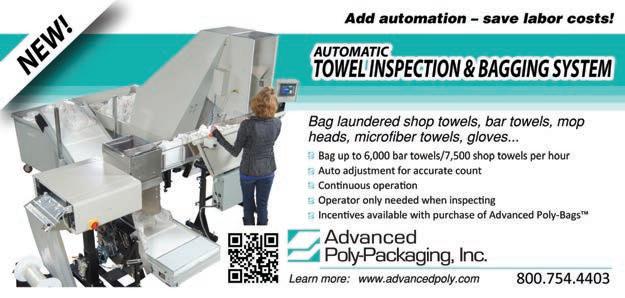
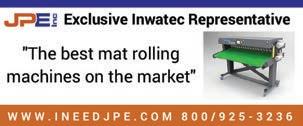
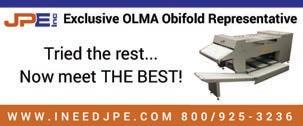













P.O. Box 400, Kenner, LA 70063 504-467-9591, Fax: 504-468-3094 www.milnor.com

www.AmericanLaundryNews.com AMERICAN LAUNDRY NEWS | OCTOBER 2016 39 Source Directory A convenient guide to sources of products and services Source Directory listings in American Laundry News are sold on an annual basis at the following rates: All Major Credit Cards Accepted 2016 Listings Regular Boldface All Caps All Caps, Boldface Four Line Listing per Year $885 $1,110 $1,110 $1,175 Display and additional line rates available upon request PARTS PARTS PARTS & SUPPLIES • Door Handles • Door Locks • Print Boards • Bearing Kits • Drain Valves • Shocks • Heating Elements • Inlet Valves and more! QUALITY LAUNDRY PARTS, GREAT PRICES For questions and custom orders email info@FrontecStore.com (941)726-0808 • Door Handles • Door Locks • Print Boards • Bearing Kits • Drain Valves • Shocks • Heating Elements • Inlet Valves and more! For questions and custom ordersFrontecStore.com (941)726-0808 CINCINNATI LAUNDRY EQUIPMENT We stock all the parts you need! We have something for everybody! Parts for All Major Manufacturers 2648 Spring Grove Avenue Cincinnati, OH 45214 Phone: 513-542-5000 • Fax: 513-542-5022 www.cincinnatilaundry.com cle@cincinnatilaundry.com Your #1 AJAX Source! AJAX • CISSELL LAVATEC • ALLIANCE IPSO • HUEBSCH JENSEN HYPRO/SUPER SYLON HOFFMAN • VOSS PERMAC • Hotel • OPL • Coin Op • Dry Cleaners • Industrial • Commercial • Cruise Industry Dry or Wet Style Filters to Work with “ALL” Dryer Sizes or Multiple Situations, Fiberglass or Stainless and Custom for Unique Situations! Lint Filters Model Big and Small – We’ve got a model for you! In-line Duct” Models – the Lint Lasso and Lint Sock –in production since 2011 All manufacturing done on premise 800-826-1245 www.cleancyclesystems.com • ccsystems@tqind.com LINT COLLECTORS & FILTERS
Pellerin Milnor Corp.
WASHERS – CONTINUOUS BATCH WASHER-EXTRACTOR – 100 POUNDS OR LESS WASHER-EXTRACTOR – 100 POUNDS OR MORE SMALL-PIECE FOLDERS MAT ROLLERS
Milnor Corp.
Pellerin Milnor Corp. P.O. Box 400, Kenner, LA 70063 504-467-9591, Fax: 504-468-3094 www.milnor.com PRESSES – EXTRACTION www.energenics.com ENERGENICS CORPORATION TALK TO OUR DESIGN AND ENGINEERING STAFF ABOUT YOUR NEEDS 1470 Don St. • Naples, FL 34104 • 800-944-1711 ›› Our In-Line Lint Filter mounts inside, saves space! ›› OPL Duct Mounted Lint Filters 1,000 to 2,700 CFM ›› Fiberglass or Stainless Steel Dry Filters ›› Hundreds Sold Annually PACKAGING SYSTEMS & SUPPLIES TO PLACE YOUR AD CALL DON FEINSTEIN 312-361-1682
Milnor
www.milnor.com
Pellerin
P.O. Box 400, Kenner, LA 70063 504-467-9591, Fax: 504-468-3094 www.milnor.com


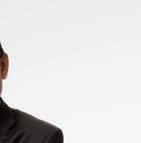
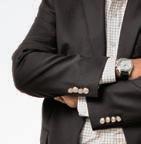


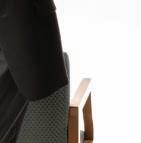
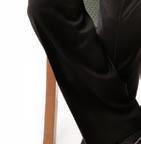
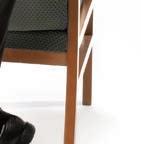



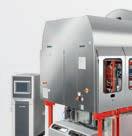
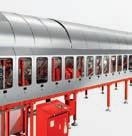


ANNIVERSARY TH













































































































































































































































 Rada
Rada







































































































































